- Server Monitoring and Management Tools
- Status LEDs and Buttons
- Preparing for Server Component Installation
- Installing or Replacing Server Components
- Replaceable Component Locations
- Replacing SAS/SATA Hard Drives or Solid State Drives
- Replacing a 2.5-Inch Form-Factor NVMe PCIe Solid State Drive
- Replacing HHHL Form Factor NVME Solid State Drives
- Replacing Fan Modules
- Replacing the Motherboard RTC Battery
- Replacing DIMMs
- Replacing CPUs and Heatsinks
- Replacing an Internal SD Card
- Enabling or Disabling the Internal USB Port
- Replacing a Cisco Modular RAID Controller Riser (Internal Riser 3)
- Replacing a Cisco Modular RAID Controller Card
- Replacing a Modular RAID Controller Transportable Memory Module (TMM)
- Replacing the Supercap Power Module (RAID Backup)
- Replacing a Software RAID 5 Key Module
- Replacing a PCIe Riser Assembly
- Replacing a PCIe Card
- Installing and Enabling a Trusted Platform Module (TPM)
- Replacing an mLOM Card
- Replacing Power Supplies
Maintaining the Server
This chapter describes how to diagnose server system problems using LEDs. It also provides information about how to install or replace hardware components, and it includes the following sections:
Server Monitoring and Management Tools
Cisco Integrated Management Interface
You can monitor the server inventory, health, and system event logs by using the built-in Cisco Integrated Management Controller (Cisco IMC) GUI or CLI interfaces. See the user documentation for your firmware release at the following URL:
http://www.cisco.com/en/US/products/ps10739/products_installation_and_configuration_guides_list.html
Server Configuration Utility
Cisco has also developed the Cisco Server Configuration Utility for C-Series servers, which can aid and simplify the following tasks:
- Monitoring server inventory and health
- Diagnosing common server problems with diagnostic tools and logs
- Setting the BIOS booting order
- Configuring some RAID configurations
- Installing operating systems
You can download the ISO image from Cisco.com. See the user documentation for your version of the utility at the following URL:
http://www.cisco.com/en/US/products/ps10493/products_user_guide_list.html
Status LEDs and Buttons
This section describes the location and meaning of LEDs and buttons and includes the following topics
Front Panel LEDs
Figure 3-1 shows the front panel LEDs. Table 3-1 defines the LED states.
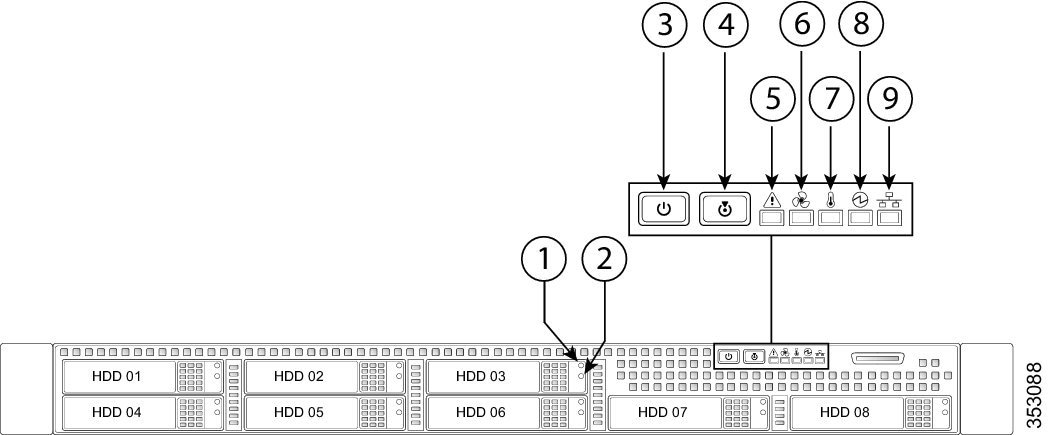
|
|
Note: NVMe PCIe SSDs drive tray LEDs have slightly different behavior. See Table 3-1 for the LED states. |
|
|
|
|
|
||
|
|
|
||
|
|
|
||
|
|
|
|
|
|
|
|---|---|---|
| Note: If your controller is a Cisco UCS RAID SAS 9300-8i or 9300-8e HBA, see Cisco UCS SAS 9300-8e HBA Considerations for differing LED behavior. |
||
|
||
– – – |
||
Rear Panel LEDs and Buttons
Figure 3-2 shows the rear panel LEDs and buttons. Table 3-2 defines the LED states.
Figure 3-2 Rear Panel LEDs and Buttons

|
|
Optional mLOM card LEDs |
|
|
|
|
|
||
|
|
|
||
|
|
|
Internal Diagnostic LEDs
The server has internal fault LEDs for CPUs, DIMMs, fan modules, SD cards, the RTC battery, and the mLOM card. These LEDs are available only when the server is in standby power mode. An LED lights amber to indicate a faulty component.
See Figure 3-3 for the locations of these internal LEDs.
Figure 3-3 Internal Diagnostic LED Locations
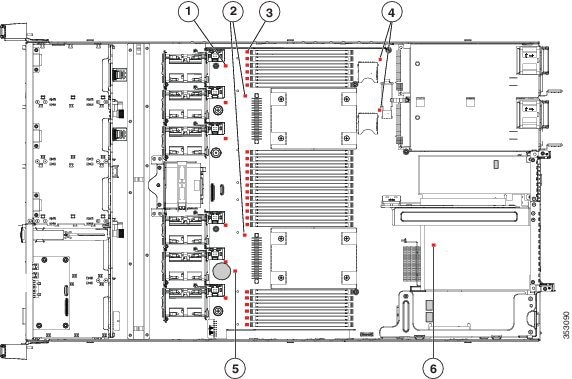
|
|
Fan module fault LEDs (one next to each fan connector on the motherboard) |
|
|
|
|
|
||
|
|
DIMM fault LEDs (one in front of each DIMM socket on the motherboard) |
|
|
|
|
|---|---|
Preparing for Server Component Installation
This section describes how to prepare for component installation, and it includes the following topics:
- Required Equipment
- Shutting Down and Powering Off the Server
- Removing and Replacing the Server Top Cover
- Serial Number Location
- Hot-Swap or Hot-Plug Replacement
Required Equipment
The following equipment is used to perform the procedures in this chapter:
Shutting Down and Powering Off the Server
The server can run in two power modes:
- Main power mode—Power is supplied to all server components and any operating system on your drives can run.
- Standby power mode—Power is supplied only to the service processor and the cooling fans and it is safe to power off the server from this mode.
You can invoke a graceful shutdown or a hard shutdown by using either of the following methods:
- Use the Cisco IMC management interface.
- Use the Power button on the server front panel. To use the Power button, follow these steps:
Step 1![]() Check the color of the Power Status LED (see the “Front Panel LEDs” section).
Check the color of the Power Status LED (see the “Front Panel LEDs” section).
- Green—The server is in main power mode and must be shut down before it can be safely powered off. Go to Step 2.
- Amber—The server is already in standby mode and can be safely powered off. Go to Step 3.
Step 2![]() Invoke either a graceful shutdown or a hard shutdown:
Invoke either a graceful shutdown or a hard shutdown:

- Graceful shutdown—Press and release the Power button. The operating system performs a graceful shutdown and the server goes to standby mode, which is indicated by an amber Power Status LED.
- Emergency shutdown—Press and hold the Power button for 4 seconds to force the main power off and immediately enter standby mode.
Step 3![]() Disconnect the power cords from the power supplies in your server to completely power off the server.
Disconnect the power cords from the power supplies in your server to completely power off the server.
Removing and Replacing the Server Top Cover
Step 1![]() Remove the top cover (see Figure 3-4).
Remove the top cover (see Figure 3-4).
a.![]() If the cover latch is locked, use a screwdriver to turn the lock 90-degrees counterclockwise to unlock it. See Figure 3-4.
If the cover latch is locked, use a screwdriver to turn the lock 90-degrees counterclockwise to unlock it. See Figure 3-4.
b.![]() Lift on the end of the latch that has the green finger grip. The cover is pushed back to the open position as you lift the latch.
Lift on the end of the latch that has the green finger grip. The cover is pushed back to the open position as you lift the latch.
c.![]() Lift the top cover straight up from the server and set it aside.
Lift the top cover straight up from the server and set it aside.

Note![]() The latch must be in the fully open position when you set the cover back in place, which allows the opening in the latch to sit over a peg that is on the fan tray.
The latch must be in the fully open position when you set the cover back in place, which allows the opening in the latch to sit over a peg that is on the fan tray.
a.![]() With the latch in the fully open position, place the cover on top of the server about one-half inch (1.27 cm) behind the lip of the front cover panel. The opening in the latch should fit over the peg that sticks up from the fan tray.
With the latch in the fully open position, place the cover on top of the server about one-half inch (1.27 cm) behind the lip of the front cover panel. The opening in the latch should fit over the peg that sticks up from the fan tray.
b.![]() Press the cover latch down to the closed position. The cover is pushed forward to the closed position as you push down the latch.
Press the cover latch down to the closed position. The cover is pushed forward to the closed position as you push down the latch.
c.![]() If desired, lock the latch by using a screwdriver to turn the lock 90-degrees clockwise.
If desired, lock the latch by using a screwdriver to turn the lock 90-degrees clockwise.
Figure 3-4 Removing the Top Cover
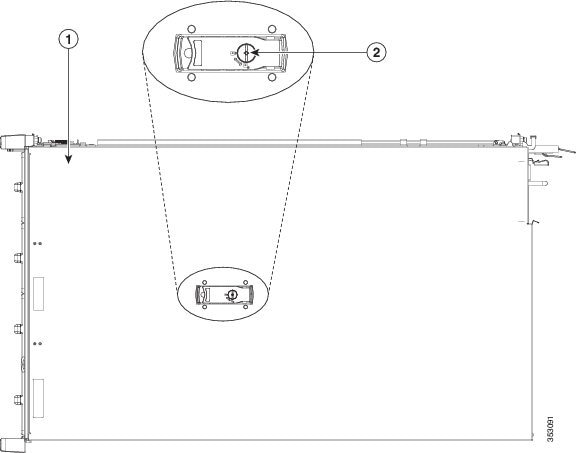
|
|
|
Serial Number Location
The serial number for the server is printed on a label on the top of the server, near the front.
Hot-Swap or Hot-Plug Replacement
Some components can be removed and replaced without powering off and removing AC power from the server. This type of replacement has two varieties: hot-swap and hot-plug.
- Hot-swap replacement—You do not have to precondition or shut down the component in the software before you remove it for the following components:
Installing or Replacing Server Components

Warning![]() Blank faceplates and cover panels serve three important functions: they prevent exposure to hazardous voltages and currents inside the chassis; they contain electromagnetic interference (EMI) that might disrupt other equipment; and they direct the flow of cooling air through the chassis. Do not operate the system unless all cards, faceplates, front covers, and rear covers are in place.
Blank faceplates and cover panels serve three important functions: they prevent exposure to hazardous voltages and currents inside the chassis; they contain electromagnetic interference (EMI) that might disrupt other equipment; and they direct the flow of cooling air through the chassis. Do not operate the system unless all cards, faceplates, front covers, and rear covers are in place.
Statement 1029


Tip![]() You can press the unit identification button on the front panel or rear panel to turn on a flashing unit identification LED on the front and rear panels of the server. This button allows you to locate the specific server that you are servicing when you go to the opposite side of the rack. You can also activate these LEDs remotely by using the Cisco IMC interface. See the “Status LEDs and Buttons” section for locations of these LEDs.
You can press the unit identification button on the front panel or rear panel to turn on a flashing unit identification LED on the front and rear panels of the server. This button allows you to locate the specific server that you are servicing when you go to the opposite side of the rack. You can also activate these LEDs remotely by using the Cisco IMC interface. See the “Status LEDs and Buttons” section for locations of these LEDs.
This section describes how to install and replace server components, and it includes the following topics:
- Replaceable Component Locations
- Replacing SAS/SATA Hard Drives or Solid State Drives
- Replacing a 2.5-Inch Form-Factor NVMe PCIe Solid State Drive
- Replacing HHHL Form Factor NVME Solid State Drives
- Replacing Fan Modules
- Replacing the Motherboard RTC Battery
- Replacing DIMMs
- Replacing CPUs and Heatsinks
- Replacing an Internal SD Card
- Enabling or Disabling the Internal USB Port
- Replacing a Cisco Modular RAID Controller Riser (Internal Riser 3)
- Replacing a Cisco Modular RAID Controller Card
- Replacing a Modular RAID Controller Transportable Memory Module (TMM)
- Replacing the Supercap Power Module (RAID Backup)
- Replacing a Software RAID 5 Key Module
- Replacing a PCIe Riser Assembly
- Replacing a PCIe Card
- Installing and Enabling a Trusted Platform Module (TPM)
- Replacing an mLOM Card
- Replacing Power Supplies
Replaceable Component Locations
This section shows the locations of the field-replaceable components. The view in Figure 3-5 is from the top down with the top cover and air baffle removed.
Figure 3-5 Replaceable Component Locations

The Technical Specifications Sheets for all versions of this server, which include supported component part numbers, are at Cisco UCS Servers Technical Specifications Sheets.
Replacing SAS/SATA Hard Drives or Solid State Drives
SAS/SATA Drive Population Guidelines
The server has two different drive backplane options:
- The small form factor (SFF), 8-drives version can hold up to eight 2.5-inch SAS/SATA hard drives or solid state drives. SAS/SATA drives are hot-swappable.
- The large form factor (LFF), 4-drives version can hold up to four 3.5-inch SAS/SATA hard drives.
The drive-bay numbering is shown in Figure 3-6.
Figure 3-6 Drive Numbering, SFF Drives, Eight-Drive Version

Figure 3-7 Drive Numbering, LFF Drives, Four-Drive Version

Observe these drive population guidelines for optimum performance:
- When populating drives, add drives to the lowest-numbered bays first.
- Keep an empty drive blanking tray in any unused bays to ensure proper airflow.
- You can mix SAS/SATA hard drives and SAS/SATA SSDs in the same server (the LFF version of the server does not support SSDs). However, you cannot configure a logical volume (virtual drive) that contains a mix of hard drives and SSDs. That is, when you create a logical volume, it must contain all SAS/SATA hard drives or all SAS/SATA SSDs.
4K Sector Format Drives Considerations
- You must boot 4K sector format drives in UEFI mode, not legacy mode. See Setting Up Booting in UEFI Mode in the BIOS Setup Utility or Setting Up Booting in UEFI Mode in the Cisco IMC GUI.
- Do not configure 4K sector format and 512-byte sector format drives as part of the same RAID volume.
- Operating system support on 4K sector drives is as follows: Windows: Win2012 and Win2012R2; Linux: RHEL 6.5, 6.6, 6.7, 7.0, 7.2; SLES 11 SP3, and SLES 12. ESXi/Vmware is not supported.
Setting Up Booting in UEFI Mode in the BIOS Setup Utility
Step 1![]() Enter the BIOS setup utility by pressing the F2 key when prompted during bootup.
Enter the BIOS setup utility by pressing the F2 key when prompted during bootup.
Step 2![]() Go to the Boot Options tab.
Go to the Boot Options tab.
Step 3![]() Set UEFI Boot Options to Enabled.
Set UEFI Boot Options to Enabled.
Step 4![]() Under Boot Option Priorities, set your OS installation media (such as a virtual DVD) as your
Under Boot Option Priorities, set your OS installation media (such as a virtual DVD) as your
Boot Option #1.
Step 5![]() Go to the Advanced tab.
Go to the Advanced tab.
Step 6![]() Select LOM and PCIe Slot Configuration.
Select LOM and PCIe Slot Configuration.
Step 7![]() Set the PCIe Slot ID: HBA Option ROM to UEFI Only.
Set the PCIe Slot ID: HBA Option ROM to UEFI Only.
Step 8![]() Press F10 to save changes and exit the BIOS setup utility. Allow the server to reboot.
Press F10 to save changes and exit the BIOS setup utility. Allow the server to reboot.
Step 9![]() After the OS installs, verify the installation:
After the OS installs, verify the installation:
a.![]() Enter the BIOS setup utility by pressing the F2 key when prompted during bootup.
Enter the BIOS setup utility by pressing the F2 key when prompted during bootup.
b.![]() Go to the Boot Options tab.
Go to the Boot Options tab.
c.![]() Under Boot Option Priorities, verify that the OS you installed is listed as your Boot Option #1.
Under Boot Option Priorities, verify that the OS you installed is listed as your Boot Option #1.
Setting Up Booting in UEFI Mode in the Cisco IMC GUI
Step 1![]() Use a web browser and the IP address of the server to log into the Cisco IMC GUI management interface.
Use a web browser and the IP address of the server to log into the Cisco IMC GUI management interface.
Step 2![]() Navigate to Server > BIOS.
Navigate to Server > BIOS.
Step 3![]() Under Actions, click Configure BIOS.
Under Actions, click Configure BIOS.
Step 4![]() In the Configure BIOS Parameters dialog, select the Advanced tab.
In the Configure BIOS Parameters dialog, select the Advanced tab.
Step 5![]() Go to the LOM and PCIe Slot Configuration section.
Go to the LOM and PCIe Slot Configuration section.
Step 6![]() Set the PCIe Slot: HBA Option ROM to UEFI Only.
Set the PCIe Slot: HBA Option ROM to UEFI Only.
Step 7![]() Click Save Changes. The dialog closes.
Click Save Changes. The dialog closes.
Step 8![]() Under BIOS Properties, set Configured Boot Order to UEFI.
Under BIOS Properties, set Configured Boot Order to UEFI.
Step 9![]() Under Actions, click Configure Boot Order.
Under Actions, click Configure Boot Order.
Step 10![]() In the Configure Boot Order dialog, click Add Local HDD.
In the Configure Boot Order dialog, click Add Local HDD.
Step 11![]() In the Add Local HDD dialog, enter the information for the 4K sector format drive and make it first in the boot order.
In the Add Local HDD dialog, enter the information for the 4K sector format drive and make it first in the boot order.
Step 12![]() Save changes and reboot the server. The changes you made will be visible after the system reboots.
Save changes and reboot the server. The changes you made will be visible after the system reboots.
Replacing a SAS/SATA Drive

Note![]() You do not have to shut down the server or drive to replace SAS/SATA hard drives or SSDs because they are hot-swappable. To replace an NVMe PCIe SSD drive, which must be shut down before removal, see Replacing a 2.5-Inch Form-Factor NVMe PCIe Solid State Drive.
You do not have to shut down the server or drive to replace SAS/SATA hard drives or SSDs because they are hot-swappable. To replace an NVMe PCIe SSD drive, which must be shut down before removal, see Replacing a 2.5-Inch Form-Factor NVMe PCIe Solid State Drive.
Step 1![]() Remove the drive that you are replacing or remove a blank drive tray from the bay:
Remove the drive that you are replacing or remove a blank drive tray from the bay:
a.![]() Press the release button on the face of the drive tray. See Figure 3-8.
Press the release button on the face of the drive tray. See Figure 3-8.
b.![]() Grasp and open the ejector lever and then pull the drive tray out of the slot.
Grasp and open the ejector lever and then pull the drive tray out of the slot.
c.![]() If you are replacing an existing drive, remove the four drive-tray screws that secure the drive to the tray and then lift the drive out of the tray.
If you are replacing an existing drive, remove the four drive-tray screws that secure the drive to the tray and then lift the drive out of the tray.
a.![]() Place a new drive in the empty drive tray and install the four drive-tray screws.
Place a new drive in the empty drive tray and install the four drive-tray screws.
b.![]() With the ejector lever on the drive tray open, insert the drive tray into the empty drive bay.
With the ejector lever on the drive tray open, insert the drive tray into the empty drive bay.
c.![]() Push the tray into the slot until it touches the backplane, and then close the ejector lever to lock the drive in place.
Push the tray into the slot until it touches the backplane, and then close the ejector lever to lock the drive in place.
Figure 3-8 Replacing Hard Drives
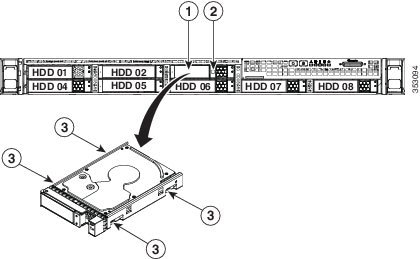
|
|
|
||
|
|
|
Replacing a 2.5-Inch Form-Factor NVMe PCIe Solid State Drive
This section is for replacing 2.5-inch small form-factor (SFF) NVMe PCIe SSDs in front-panel drive bays. To replace HHHL form-factor NVMe PCIe SSDs in the PCIe slots, see Replacing HHHL Form Factor NVME Solid State Drives.
2.5-Inch Form-Factor NVMe PCIe SSD Population Guidelines
The SFF 8-drive version of the server supports up to two NVMe SFF 2.5-inch SSDs in drive bays 1 and 2 only.
2.5-inch Form-Factor NVME PCIe SSD Requirements and Restrictions
Observe these requirements for NVMe SFF 2.5-inch SSDs:
- Only the SFF, 8-drives version of the server supports NVMe SFF 2.5-inch SSDs.
- The server must have two CPUs. PCIe riser 2 is not available in a single-CPU system (the PCIe riser carries the PCIe signal from the front panel drive bays).
- PCIe riser version 2B (UCSC-PCI-2B-220M4), with bundled cables. This version of the riser has cable connectors for the PCIe cables that connect to the drive backplane.
Observe these restrictions for NVMe SFF 2.5-inch SSDs:
- You can boot (UEFI only) from an NVMe SFF 2.5-inch SSD only with Cisco IMC 2.0(13) or later server firmware. For Cisco UCS Manager-integrated servers, booting is supported only with Cisco UCS Manager 3.1(2) or later software.
- NVMe SFF 2.5-inch SSDs support booting only in UEFI mode. Legacy boot is not supported.
- You cannot control NVMe PCIe SSDs with a SAS RAID controller because they communicate with the server via the PCIe bus.
- You can combine NVMe SFF 2.5-inch SSDs and HHHL form-factor SSDs in the same system, but the same partner brand must be used. For example, two Intel NVMe SFF 2.5-inch SSDs and two HHHL form-factor HGST SSDs is an invalid configuration. A valid configuration is two HGST NVMe SFF 2.5-inch SSDs and two HGST HHHL form-factor SSDs.
- UEFI boot is supported in the five operating systems listed in Table 3-4 , when your server is running Cisco IMC 2.0(13) or later firmware. Refer to this table for OS-informed hot-insertion and hot-removal support by operating system:
|
|
|
|
|
|
|
|
|---|---|---|---|---|---|---|
Enabling Hot-Plug Support in the System BIOS
In Cisco IMC 2.0(13) and later, hot-plug (OS-informed hot-insertion and hot-removal) is disabled in the system BIOS by default.
Enabling Hot-Plug Support in the BIOS Setup Utility
Step 1![]() Enter the BIOS setup utility by pressing the F2 key when prompted during bootup.
Enter the BIOS setup utility by pressing the F2 key when prompted during bootup.
Step 2![]() Locate the setting: Advanced > PCI Subsystem Settings > NVMe SSD Hot-Plug Support.
Locate the setting: Advanced > PCI Subsystem Settings > NVMe SSD Hot-Plug Support.
Step 3![]() Set the value to Enabled.
Set the value to Enabled.
Step 4![]() Save your changes and exit the utility.
Save your changes and exit the utility.
Enabling Hot-Plug Support in the Cisco IMC GUI
Step 1![]() Use a browser to log into the Cisco IMC GUI for the system.
Use a browser to log into the Cisco IMC GUI for the system.
Step 2![]() Navigate to Compute > BIOS > Advanced > PCI Configuration.
Navigate to Compute > BIOS > Advanced > PCI Configuration.
Step 3![]() Set NVME SSD Hot-Plug Support to Enabled.
Set NVME SSD Hot-Plug Support to Enabled.
Step 4![]() Save your changes and exit the software.
Save your changes and exit the software.
Replacing a 2.5-inch Form-Factor NVMe PCIe SSD

Note![]() OS-surprise removal is not supported. OS-informed hot-insertion and hot-removal are supported only with Cisco IMC release 2.0(13) and later and they depend on your OS version. See Table 3-4 for support by OS.
OS-surprise removal is not supported. OS-informed hot-insertion and hot-removal are supported only with Cisco IMC release 2.0(13) and later and they depend on your OS version. See Table 3-4 for support by OS.

Note![]() OS-informed hot-insertion and hot-removal must be enabled in the system BIOS. See Enabling Hot-Plug Support in the System BIOS.
OS-informed hot-insertion and hot-removal must be enabled in the system BIOS. See Enabling Hot-Plug Support in the System BIOS.
For information about drive tray LEDs, see Front Panel LEDs.
Step 1![]() Remove an existing NVMe SFF 2.5-inch SSD:
Remove an existing NVMe SFF 2.5-inch SSD:
a.![]() Shut down the NVMe SFF 2.5-inch SSD to initiate an OS-informed removal. Use your operating system interface to shut down the drive, and then observe the drive-tray LED:
Shut down the NVMe SFF 2.5-inch SSD to initiate an OS-informed removal. Use your operating system interface to shut down the drive, and then observe the drive-tray LED:
–![]() Green—The drive is in use and functioning properly. Do not remove.
Green—The drive is in use and functioning properly. Do not remove.
–![]() Green, blinking—the driver is unloading following a shutdown command. Do not remove.
Green, blinking—the driver is unloading following a shutdown command. Do not remove.
–![]() Off—The drive is not in use and can be safely removed.
Off—The drive is not in use and can be safely removed.
b.![]() Press the release button on the face of the drive tray. See Figure 3-8.
Press the release button on the face of the drive tray. See Figure 3-8.
c.![]() Grasp and open the ejector lever and then pull the drive tray out of the slot.
Grasp and open the ejector lever and then pull the drive tray out of the slot.
d.![]() If you are replacing an existing SSD, remove the four drive tray screws that secure the SSD to the tray and then lift the SSD out of the tray.
If you are replacing an existing SSD, remove the four drive tray screws that secure the SSD to the tray and then lift the SSD out of the tray.

Note![]() If this is the first time that NVMe SFF 2.5-inch SSDs are being installed in the server, you must install PCIe riser version 2B and connect its cables before installing the drive. See Installing PCIe Riser Version 2B For NVMe SFF 2.5-Inch SSDs.
If this is the first time that NVMe SFF 2.5-inch SSDs are being installed in the server, you must install PCIe riser version 2B and connect its cables before installing the drive. See Installing PCIe Riser Version 2B For NVMe SFF 2.5-Inch SSDs.
Step 2![]() Install a new NVMe SFF 2.5-inch SSD:
Install a new NVMe SFF 2.5-inch SSD:
a.![]() Place a new SSD in the empty drive tray and replace the four drive tray screws.
Place a new SSD in the empty drive tray and replace the four drive tray screws.
b.![]() With the ejector lever on the drive tray open, insert the drive tray into the empty drive bay.
With the ejector lever on the drive tray open, insert the drive tray into the empty drive bay.
c.![]() Push the tray into the slot until it touches the backplane, and then close the ejector lever to lock the drive in place.
Push the tray into the slot until it touches the backplane, and then close the ejector lever to lock the drive in place.
Step 3![]() Observe the drive-tray LED and wait until it returns to solid green before accessing the drive:
Observe the drive-tray LED and wait until it returns to solid green before accessing the drive:
- Off—The drive is not in use.
- Green, blinking—the driver is initializing following hot-plug insertion.
- Green—The drive is in use and functioning properly.
Installing PCIe Riser Version 2B For NVMe SFF 2.5-Inch SSDs
PCIe Riser Version 2B (UCSC-PCI-2B-220M4) has two cable connectors that are used to provide communication from the front-panel drive bays to the PCIe bus.
Figure 3-9 PCIe Riser Assembly UCSC-PCI-2B-C220M4
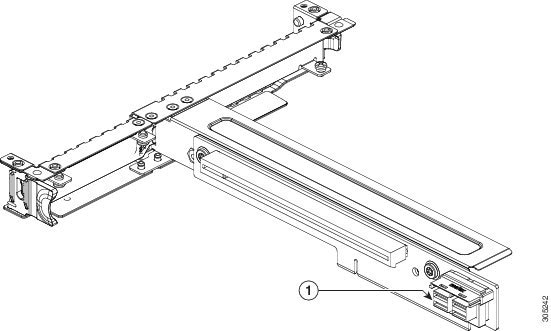
|
|
|
Step 1![]() Remove an existing PCIe riser assembly that you are replacing:
Remove an existing PCIe riser assembly that you are replacing:
a.![]() Power off the server as described in Shutting Down and Powering Off the Server.
Power off the server as described in Shutting Down and Powering Off the Server.
b.![]() Slide the server out the front of the rack far enough so that you can remove the top cover. You might have to detach cables from the rear panel to provide clearance.
Slide the server out the front of the rack far enough so that you can remove the top cover. You might have to detach cables from the rear panel to provide clearance.

c.![]() Remove the top cover as described in Removing and Replacing the Server Top Cover.
Remove the top cover as described in Removing and Replacing the Server Top Cover.
d.![]() Use two hands to grasp the metal bracket of the riser assembly and lift straight up to disengage its connectors from the two sockets on the motherboard.
Use two hands to grasp the metal bracket of the riser assembly and lift straight up to disengage its connectors from the two sockets on the motherboard.
e.![]() If the riser has any cards installed, remove them from the riser.
If the riser has any cards installed, remove them from the riser.
Step 2![]() Install a new PCIe riser assembly Version 2B:
Install a new PCIe riser assembly Version 2B:
a.![]() If you removed any cards from the old riser assembly, install the cards to the new riser assembly (see Replacing a PCIe Card).
If you removed any cards from the old riser assembly, install the cards to the new riser assembly (see Replacing a PCIe Card).
b.![]() Position the riser assembly over its two sockets on the motherboard and over the chassis alignment channels (see Figure 3-27):
Position the riser assembly over its two sockets on the motherboard and over the chassis alignment channels (see Figure 3-27):
c.![]() Carefully push down on both ends of the riser assembly to fully engage its connectors with the two sockets on the motherboard.
Carefully push down on both ends of the riser assembly to fully engage its connectors with the two sockets on the motherboard.
Step 3![]() Connect the two cables that come with UCSC-PCI-2B-220M4:
Connect the two cables that come with UCSC-PCI-2B-220M4:
a.![]() Connect both cable connectors to the two connectors on the riser 2B (see Figure 3-10).
Connect both cable connectors to the two connectors on the riser 2B (see Figure 3-10).
b.![]() Route the cables to the front of the server using the recommended path through the chassis cable guides as shown in Figure 3-10.
Route the cables to the front of the server using the recommended path through the chassis cable guides as shown in Figure 3-10.
c.![]() Connect the two ends of the cable to the PCIe connectors on the drive backplane.
Connect the two ends of the cable to the PCIe connectors on the drive backplane.
Connect the cable labeled Port A to the Port A connector; connect the cable labeled Port B to the Port B connector (see Figure 3-10).
Step 5![]() Replace the server in the rack, replace cables, and then power on the server by pressing the Power button.
Replace the server in the rack, replace cables, and then power on the server by pressing the Power button.
Figure 3-10 PCIe Riser Version 2B Cabling to Drive Backplane
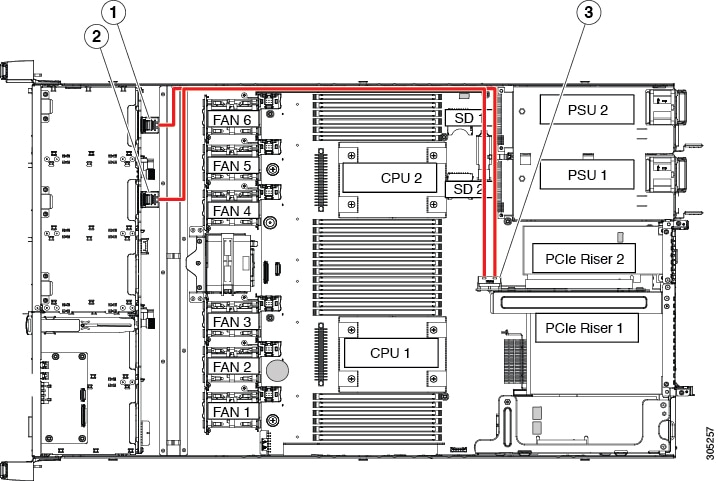
|
|
|
||
|
|
|
Replacing HHHL Form Factor NVME Solid State Drives
The half-height, half-length (HHHL) form-factor NVMe PCIe SSDs install to the PCIe riser slots. To install an NVMe SFF 2.5-inch form-factor PCIe SSD in the front-panel drive bays, see Replacing a 2.5-Inch Form-Factor NVMe PCIe Solid State Drive.
HHHL Form-Factor NVMe PCIe SSD Population Guidelines
Observe the following population guidelines when installing HHHL form-factor NVMe SSDs:
- Two-CPU systems—You can populate up to 2 HHHL form-factor SSDs, using PCIe slots 1 – 2.
- One-CPU systems—In a single-CPU system, PCIe riser 2/slot 2 is not available. Therefore, the maximum number of HHHL form-factor SSDs you can populate is 1, in PCIe slot 1.
|
|
|
|---|---|
HHHL Form-Factor NVME PCIe SSD Requirements and Restrictions
Observe these requirements for HHHL form-factor NVMe SSDs:
- Both versions of the server support HHHL form-factor NVMe SSDs (LFF 4-drives and SFF 8-drives versions of the server).
Observe these restrictions for NVMe PCIe SSDs:
- You cannot boot from an HHHL form-factor NVMe SSD.
- You cannot control an HHHL form-factor NVMe SSD with a SAS RAID controller because they communicate with the server via the PCIe bus.
- You can combine NVMe SFF 2.5-inch SSDs and HHHL form-factor SSDs in the same system, but the same partner brand must be used. For example, two Intel NVMe SFF 2.5-inch SSDs and two HHHL form-factor HGST SSDs is an invalid configuration. A valid configuration is two HGST NVMe SFF 2.5-inch SSDs and two HGST HHHL form-factor SSDs.
Replacing an HHHL Form-Factor NVMe PCIe SSD

Note![]() In a single-CPU server, PCIe riser 2 (PCIe slot 2) is not available.
In a single-CPU server, PCIe riser 2 (PCIe slot 2) is not available.
Step 1![]() Remove an existing HHHL form-factor NVME SSD (or a blank filler panel) from the PCIe riser:
Remove an existing HHHL form-factor NVME SSD (or a blank filler panel) from the PCIe riser:
a.![]() Shut down and power off the server as described in Shutting Down and Powering Off the Server.
Shut down and power off the server as described in Shutting Down and Powering Off the Server.
b.![]() Slide the server out the front of the rack far enough so that you can remove the top cover. You might have to detach cables from the rear panel to provide clearance.
Slide the server out the front of the rack far enough so that you can remove the top cover. You might have to detach cables from the rear panel to provide clearance.

c.![]() Remove the top cover as described in Removing and Replacing the Server Top Cover.
Remove the top cover as described in Removing and Replacing the Server Top Cover.
d.![]() Use two hands to grasp the metal bracket of the riser assembly and lift straight up to disengage its connectors from the two sockets on the motherboard.
Use two hands to grasp the metal bracket of the riser assembly and lift straight up to disengage its connectors from the two sockets on the motherboard.
e.![]() Open the hinged plastic retainer that secures the rear-panel tab of the card (see Figure 3-11).
Open the hinged plastic retainer that secures the rear-panel tab of the card (see Figure 3-11).
f.![]() Pull evenly on both ends of the HHHL form-factor NVME SSD to remove it from the socket on the PCIe riser.
Pull evenly on both ends of the HHHL form-factor NVME SSD to remove it from the socket on the PCIe riser.
If the riser has no SSD, remove the blanking panel from the rear opening of the riser.
Step 2![]() Install a new HHHL form-factor NVME SSD:
Install a new HHHL form-factor NVME SSD:
a.![]() Open the hinged plastic retainer
Open the hinged plastic retainer
b.![]() With the hinged tab retainer open, align the new SSD with the empty socket on the PCIe riser.
With the hinged tab retainer open, align the new SSD with the empty socket on the PCIe riser.
c.![]() Push down evenly on both ends of the card until it is fully seated in the socket.
Push down evenly on both ends of the card until it is fully seated in the socket.
d.![]() Ensure that the SSD’s rear panel tab sits flat against the riser rear-panel opening and then close the hinged tab retainer over the card’s rear-panel tab (see Figure 3-11).
Ensure that the SSD’s rear panel tab sits flat against the riser rear-panel opening and then close the hinged tab retainer over the card’s rear-panel tab (see Figure 3-11).
e.![]() Position the PCIe riser over its two sockets on the motherboard and over the chassis alignment channels (see Figure 3-27).
Position the PCIe riser over its two sockets on the motherboard and over the chassis alignment channels (see Figure 3-27).
f.![]() Carefully push down on both ends of the PCIe riser to fully engage its connector with the sockets on the motherboard.
Carefully push down on both ends of the PCIe riser to fully engage its connector with the sockets on the motherboard.
h.![]() Replace the server in the rack, replace cables, and then power on the server by pressing the Power button.
Replace the server in the rack, replace cables, and then power on the server by pressing the Power button.
Figure 3-11 PCIe Riser Assembly Showing UCSC-PCI-2B-C220M4
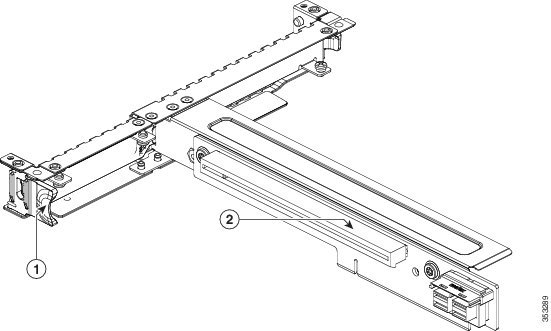
|
|
|
Replacing Fan Modules
The six fan modules in the server are numbered as follows when you are facing the front of the server (also see Figure 3-13).
Figure 3-12 Fan Module Numbering

Tip![]() Each fan module has a fault LED next to the fan connector on the motherboard that lights amber if the fan module fails. Standby power is required to operate these LEDs.
Each fan module has a fault LED next to the fan connector on the motherboard that lights amber if the fan module fails. Standby power is required to operate these LEDs.

Step 1![]() Remove a fan module that you are replacing (see Figure 3-13):
Remove a fan module that you are replacing (see Figure 3-13):
a.![]() Slide the server out the front of the rack far enough so that you can remove the top cover. You might have to detach cables from the rear panel to provide clearance.
Slide the server out the front of the rack far enough so that you can remove the top cover. You might have to detach cables from the rear panel to provide clearance.

b.![]() Remove the top cover as described in Removing and Replacing the Server Top Cover.
Remove the top cover as described in Removing and Replacing the Server Top Cover.
c.![]() Grasp the fan module at its front and on the green connector. Lift straight up to disengage its connector from the motherboard and free it from the two alignment pegs.
Grasp the fan module at its front and on the green connector. Lift straight up to disengage its connector from the motherboard and free it from the two alignment pegs.
Step 2![]() Install a new fan module:
Install a new fan module:
a.![]() Set the new fan module in place, aligning its two openings with the two alignment pegs on the motherboard. See Figure 3-13.
Set the new fan module in place, aligning its two openings with the two alignment pegs on the motherboard. See Figure 3-13.
b.![]() Press down gently on the fan module connector to fully engage it with the connector on the motherboard.
Press down gently on the fan module connector to fully engage it with the connector on the motherboard.
d.![]() Replace the server in the rack.
Replace the server in the rack.
Figure 3-13 Top View of Fan Module
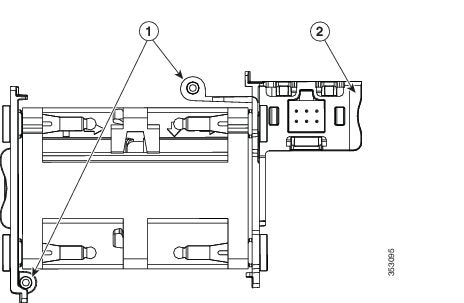
|
|
|
Replacing the Motherboard RTC Battery

Warning![]() There is danger of explosion if the battery is replaced incorrectly. Replace the battery only with the same or equivalent type recommended by the manufacturer. Dispose of used batteries according to the manufacturer’s instructions. [Statement 1015]
There is danger of explosion if the battery is replaced incorrectly. Replace the battery only with the same or equivalent type recommended by the manufacturer. Dispose of used batteries according to the manufacturer’s instructions. [Statement 1015]
The real-time clock (RTC) battery retains system settings when the server is disconnected from power. The battery type is CR2032. Cisco supports the industry-standard CR2032 battery, which can be purchased from most electronic stores.
Step 1![]() Remove the RTC battery (see Figure 3-14):
Remove the RTC battery (see Figure 3-14):
a.![]() Power off the server as described in Shutting Down and Powering Off the Server.
Power off the server as described in Shutting Down and Powering Off the Server.
b.![]() Slide the server out the front of the rack far enough so that you can remove the top cover. You might have to detach cables from the rear panel to provide clearance.
Slide the server out the front of the rack far enough so that you can remove the top cover. You might have to detach cables from the rear panel to provide clearance.

c.![]() Remove the top cover as described in Removing and Replacing the Server Top Cover.
Remove the top cover as described in Removing and Replacing the Server Top Cover.
d.![]() Locate the RTC battery. See Figure 3-14.
Locate the RTC battery. See Figure 3-14.
e.![]() Gently remove the battery from the holder on the motherboard.
Gently remove the battery from the holder on the motherboard.
Step 2![]() Install an RTC battery:
Install an RTC battery:
a.![]() Insert the battery into its holder and press down until it clicks in place.
Insert the battery into its holder and press down until it clicks in place.

Note![]() The positive side of the battery marked “3V+” should face upward.
The positive side of the battery marked “3V+” should face upward.
c.![]() Replace the server in the rack, replace cables, and power on the server by pressing the Power button.
Replace the server in the rack, replace cables, and power on the server by pressing the Power button.
Figure 3-14 Motherboard RTC Battery Location
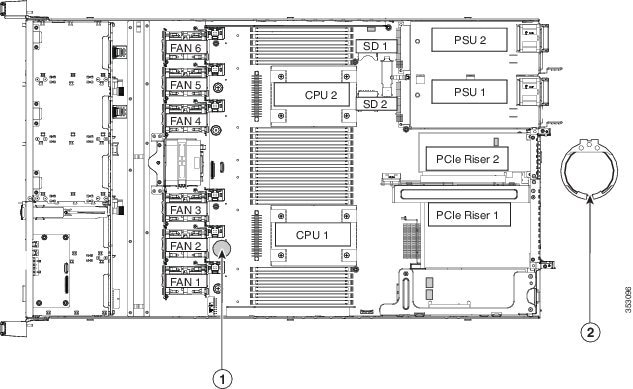
|
|
|
Replacing DIMMs
This section includes the following topics:



Note![]() To ensure the best server performance, it is important that you are familiar with memory performance guidelines and population rules before you install or replace DIMMs.
To ensure the best server performance, it is important that you are familiar with memory performance guidelines and population rules before you install or replace DIMMs.
Memory Performance Guidelines and Population Rules
This section describes the type of memory that the server requires and its effect on performance. The section includes the following topics:
DIMM Slot Numbering
Figure 3-15 shows the numbering of the DIMM slots.
Figure 3-15 DIMM Slots and CPUs

DIMM Population Rules
Observe the following guidelines when installing or replacing DIMMs:
Observe the following guidelines when installing or replacing DIMMs:
–![]() CPU1 supports channels A, B, C, and D.
CPU1 supports channels A, B, C, and D.
–![]() CPU2 supports channels E, F, G, and H.
CPU2 supports channels E, F, G, and H.
–![]() A channel can operate with one, two, or three DIMMs installed.
A channel can operate with one, two, or three DIMMs installed.
–![]() If a channel has only one DIMM, populate slot 1 first (the blue slot).
If a channel has only one DIMM, populate slot 1 first (the blue slot).
–![]() Fill blue #1 slots in the channels first: A1, E1, B1, F1, C1, G1, D1, H1
Fill blue #1 slots in the channels first: A1, E1, B1, F1, C1, G1, D1, H1
–![]() Fill black #2 slots in the channels second: A2, E2, B2, F2, C2, G2, D2, H2
Fill black #2 slots in the channels second: A2, E2, B2, F2, C2, G2, D2, H2
–![]() Fill white #3 slots in the channels third: A3, E3, B3, F3, C3, G3, D3, H3
Fill white #3 slots in the channels third: A3, E3, B3, F3, C3, G3, D3, H3
- Any DIMM installed in a DIMM socket for which the CPU is absent is not recognized. In a single-CPU configuration, populate the channels for CPU1 only (A, B, C, D).
- Memory mirroring reduces the amount of memory available by 50 percent because only one of the two populated channels provides data. When memory mirroring is enabled, DIMMs must be installed in sets of 4, 6, or 8 as described in Memory Mirroring and RAS.
- Observe the DIMM mixing rules shown in Table 3-5 .
Memory Mirroring and RAS
The Intel E5-2600 CPUs within the server support memory mirroring only when an even number of channels are populated with DIMMs. If one or three channels are populated with DIMMs, memory mirroring is automatically disabled. Furthermore, if memory mirroring is used, DRAM size is reduced by 50 percent for reasons of reliability.
For details on populating recommended memory mirroring configurations, see the specification sheet for the server:
Lockstep Channel Mode
When you enable lockstep channel mode, each memory access is a 128-bit data access that spans four channels.
Lockstep channel mode requires that all four memory channels on a CPU must be populated identically with regard to size and organization. DIMM socket populations within a channel (for example, A1, A2, A3) do not have to be identical but the same DIMM slot location across all four channels must be populated the same.
For example, DIMMs in sockets A1, B1, C1, and D1 must be identical. DIMMs in sockets A2, B2, C2, and D2 must be identical. However, the A1-B1-C1-D1 DIMMs do not have to be identical with the A2-B2-C2-D2 DIMMs.
DIMM Replacement Procedure
Identifying a Faulty DIMM
Each DIMM socket has a corresponding DIMM fault LED, directly in front of the DIMM socket. See Figure 3-3 for the locations of these LEDs. The LEDs light amber to indicate a faulty DIMM. To operate these LEDs from the SuperCap power source, remove AC power cords and then press the unit identification button. See also Internal Diagnostic LEDs.
Replacing DIMMs
Step 1![]() Remove the DIMM that you are replacing:
Remove the DIMM that you are replacing:
a.![]() Power off the server as described in the Shutting Down and Powering Off the Server.
Power off the server as described in the Shutting Down and Powering Off the Server.
b.![]() Slide the server out the front of the rack far enough so that you can remove the top cover. You might have to detach cables from the rear panel to provide clearance.
Slide the server out the front of the rack far enough so that you can remove the top cover. You might have to detach cables from the rear panel to provide clearance.

c.![]() Remove the top cover as described in Removing and Replacing the Server Top Cover.
Remove the top cover as described in Removing and Replacing the Server Top Cover.
d.![]() Identify the faulty DIMM by observing the DIMM slot fault LEDs on the motherboard.
Identify the faulty DIMM by observing the DIMM slot fault LEDs on the motherboard.
e.![]() Open the ejector levers at both ends of the DIMM slot, and then lift the DIMM out of the slot.
Open the ejector levers at both ends of the DIMM slot, and then lift the DIMM out of the slot.

Note![]() Before installing DIMMs, see the population guidelines: Memory Performance Guidelines and Population Rules.
Before installing DIMMs, see the population guidelines: Memory Performance Guidelines and Population Rules.
f.![]() Align the new DIMM with the empty slot on the motherboard. Use the alignment key in the DIMM slot to correctly orient the DIMM.
Align the new DIMM with the empty slot on the motherboard. Use the alignment key in the DIMM slot to correctly orient the DIMM.
g.![]() Push down evenly on the top corners of the DIMM until it is fully seated and the ejector levers on both ends lock into place.
Push down evenly on the top corners of the DIMM until it is fully seated and the ejector levers on both ends lock into place.
i.![]() Replace the server in the rack, replace cables, and then power on the server by pressing the Power button.
Replace the server in the rack, replace cables, and then power on the server by pressing the Power button.
Replacing CPUs and Heatsinks
Special Information For Upgrades to Intel Xeon v4 CPUs

The minimum software and firmware versions required for the server to support Intel v4 CPUs are as follows:
|
|
|
|---|---|

Note![]() Cisco UCS Manager Release 2.2(4) introduced a server pack feature that allows Intel v4 CPUs to run with Cisco UCS Manager Release 2.2(4) or later.
Cisco UCS Manager Release 2.2(4) introduced a server pack feature that allows Intel v4 CPUs to run with Cisco UCS Manager Release 2.2(4) or later.
The UCS Manager Capability Catalog must be updated to 2.2(7c) or later.
The server Cisco IMC/BIOS must be running the minimum version or later as described in Table 3-6.
Do one of the following actions:
- If your server’s firmware and/or Cisco UCS Manager software are already at the required levels shown in Table 3-6 , you can replace the CPU hardware by using the procedure in this section.
- If your server’s firmware and/or Cisco UCS Manager software is earlier than the required levels, use the instructions in the Cisco UCS C-Series Servers Upgrade Guide for Intel Xeon v4 CPUs to upgrade your software. After you upgrade the software, return to the procedure in this section as directed to replace the CPU hardware.
CPU Configuration Rules
This server has two CPU sockets. Each CPU supports four DIMM channels (12 DIMM slots). See Figure 3-15.
- The server can operate with one CPU or two identical CPUs installed.
- The minimum configuration is that the server must have at least CPU1 installed. Install CPU1 first, and then CPU2.
- The following restrictions apply when using a single-CPU configuration:
–![]() The maximum number of DIMMs is 12 (only CPU1 channels A, B, C, and D).
The maximum number of DIMMs is 12 (only CPU1 channels A, B, C, and D).
CPU Replacement Procedure


Note![]() This server uses the new independent loading mechanism (ILM) CPU sockets, so no Pick-and-Place tools are required for CPU handling or installation. Always grasp the plastic frame on the CPU when handling.
This server uses the new independent loading mechanism (ILM) CPU sockets, so no Pick-and-Place tools are required for CPU handling or installation. Always grasp the plastic frame on the CPU when handling.
Step 1![]() Power off the server as described in Shutting Down and Powering Off the Server.
Power off the server as described in Shutting Down and Powering Off the Server.
Step 2![]() Slide the server out the front of the rack far enough so that you can remove the top cover. You might have to detach cables from the rear panel to provide clearance.
Slide the server out the front of the rack far enough so that you can remove the top cover. You might have to detach cables from the rear panel to provide clearance.

Step 3![]() Remove the top cover as described in Removing and Replacing the Server Top Cover.
Remove the top cover as described in Removing and Replacing the Server Top Cover.
Step 4![]() Remove the plastic air baffle that sits over the CPUs.
Remove the plastic air baffle that sits over the CPUs.
Step 5![]() Remove the heatsink that you are replacing. Use a Number 2 Phillips-head screwdriver to loosen the four captive screws that secure the heatsink and then lift it off of the CPU.
Remove the heatsink that you are replacing. Use a Number 2 Phillips-head screwdriver to loosen the four captive screws that secure the heatsink and then lift it off of the CPU.

Note![]() Alternate loosening each screw evenly to avoid damaging the heatsink or CPU.
Alternate loosening each screw evenly to avoid damaging the heatsink or CPU.
Step 6![]() Open the CPU retaining mechanism:
Open the CPU retaining mechanism:
a.![]() Unclip the first retaining latch labeled with the
Unclip the first retaining latch labeled with the  icon, and then unclip the second retaining latch labeled with the
icon, and then unclip the second retaining latch labeled with the  icon. See Figure 3-16.
icon. See Figure 3-16.
b.![]() Open the hinged CPU cover plate.
Open the hinged CPU cover plate.
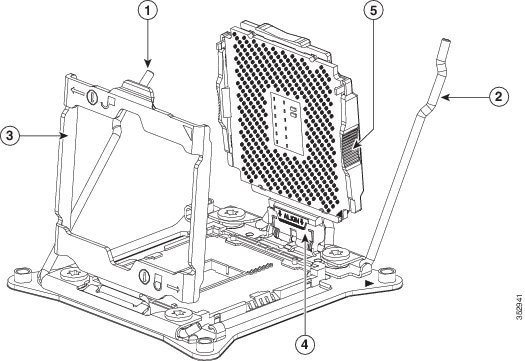
|
|
|
||
|
|
|
||
|
|
|
Step 7![]() Remove any existing CPU:
Remove any existing CPU:
a.![]() With the latches and hinged CPU cover plate open, swing up the CPU in its hinged seat to the open position, as shown in Figure 3-16.
With the latches and hinged CPU cover plate open, swing up the CPU in its hinged seat to the open position, as shown in Figure 3-16.
b.![]() Grasp the CPU by the finger grips on its plastic frame and lift it up and out of the hinged CPU seat.
Grasp the CPU by the finger grips on its plastic frame and lift it up and out of the hinged CPU seat.
c.![]() Set the CPU aside on an anti-static surface.
Set the CPU aside on an anti-static surface.
a.![]() Grasp the new CPU by the finger grips on its plastic frame and align the tab on the frame that is labeled “ALIGN” with the SLS mechanism, as shown in Figure 3-17.
Grasp the new CPU by the finger grips on its plastic frame and align the tab on the frame that is labeled “ALIGN” with the SLS mechanism, as shown in Figure 3-17.
b.![]() Insert the tab on the CPU frame into the seat until it stops and is held firmly.
Insert the tab on the CPU frame into the seat until it stops and is held firmly.
The line below the word “ALIGN” should be level with the edge of the seat, as shown in Figure 3-17.
c.![]() Swing the hinged seat with the CPU down until the CPU frame clicks in place and holds flat in the socket.
Swing the hinged seat with the CPU down until the CPU frame clicks in place and holds flat in the socket.
d.![]() Close the hinged CPU cover plate.
Close the hinged CPU cover plate.
e.![]() Clip down the CPU retaining latch with the
Clip down the CPU retaining latch with the  icon, and then clip down the CPU retaining latch with the
icon, and then clip down the CPU retaining latch with the  icon. See Figure 3-16.
icon. See Figure 3-16.
Figure 3-17 CPU and Socket Alignment Features
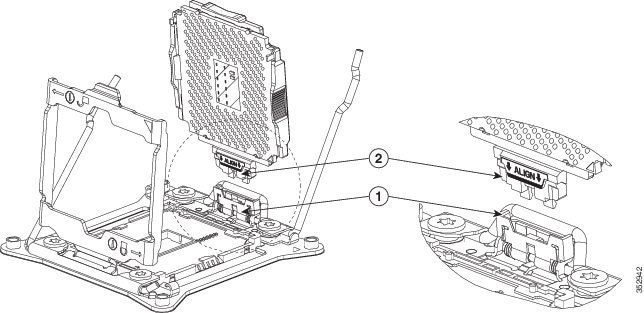
|
|
|

a.![]() Apply the cleaning solution, which is included with the heatsink cleaning kit (UCSX-HSCK=, shipped with spare CPUs), to the old thermal grease on the heatsink and CPU and let it soak for a least 15 seconds.
Apply the cleaning solution, which is included with the heatsink cleaning kit (UCSX-HSCK=, shipped with spare CPUs), to the old thermal grease on the heatsink and CPU and let it soak for a least 15 seconds.
b.![]() Wipe all of the old thermal grease off the old heat sink and CPU using the soft cloth that is included with the heatsink cleaning kit. Be careful to not scratch the heat sink surface.
Wipe all of the old thermal grease off the old heat sink and CPU using the soft cloth that is included with the heatsink cleaning kit. Be careful to not scratch the heat sink surface.

Note![]() New heatsinks come with a pre-applied pad of thermal grease. If you are reusing a heatsink, you must apply thermal grease from a syringe (UCS-CPU-GREASE3=).
New heatsinks come with a pre-applied pad of thermal grease. If you are reusing a heatsink, you must apply thermal grease from a syringe (UCS-CPU-GREASE3=).
c.![]() Using the syringe of thermal grease provided with the CPU (UCS-CPU-GREASE3=), apply 2 cubic centimeters of thermal grease to the top of the CPU. Use the pattern shown in Figure 3-18 to ensure even coverage.
Using the syringe of thermal grease provided with the CPU (UCS-CPU-GREASE3=), apply 2 cubic centimeters of thermal grease to the top of the CPU. Use the pattern shown in Figure 3-18 to ensure even coverage.
Figure 3-18 Thermal Grease Application Pattern
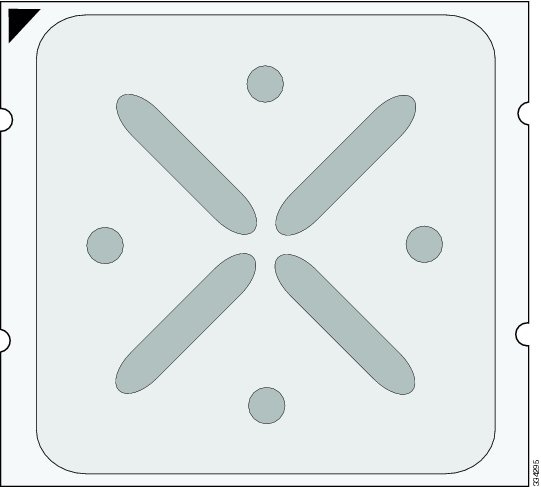
d.![]() Align the four heatsink captive screws with the motherboard standoffs, and then use a Number 2 Phillips-head screwdriver to tighten the captive screws evenly.
Align the four heatsink captive screws with the motherboard standoffs, and then use a Number 2 Phillips-head screwdriver to tighten the captive screws evenly.

Note![]() Alternate tightening each screw evenly to avoid damaging the heatsink or CPU.
Alternate tightening each screw evenly to avoid damaging the heatsink or CPU.
Step 10![]() Replace the air baffle.
Replace the air baffle.
Step 11![]() Replace the top cover.
Replace the top cover.
Step 12![]() Replace the server in the rack, replace cables, and then power on the server by pressing the Power button.
Replace the server in the rack, replace cables, and then power on the server by pressing the Power button.
Additional CPU-Related Parts to Order with RMA Replacement Motherboards
When a return material authorization (RMA) of the motherboard or CPU is done on a Cisco UCS C-series server, additional parts might not be included with the CPU or motherboard spare bill of materials (BOM). The TAC engineer might need to add the additional parts to the RMA to help ensure a successful replacement.
–![]() Heat sink cleaning kit (UCSX-HSCK=)
Heat sink cleaning kit (UCSX-HSCK=)
–![]() Thermal grease kit for C240 M4 (UCS-CPU-GREASE3=)
Thermal grease kit for C240 M4 (UCS-CPU-GREASE3=)
–![]() Heat sink cleaning kit (UCSX-HSCK=)
Heat sink cleaning kit (UCSX-HSCK=)
A CPU heatsink cleaning kit is good for up to four CPU and heatsink cleanings. The cleaning kit contains two bottles of solution, one to clean the CPU and heatsink of old thermal interface material and the other to prepare the surface of the heatsink.
New heatsink spares come with a pre-applied pad of thermal grease. It is important to clean the old thermal grease off of the CPU prior to installing the heatsinks. Therefore, when you are ordering new heatsinks, you must order the heatsink cleaning kit.
Replacing an Internal SD Card
The server has two internal SD card bays on the motherboard.
Dual SD cards are supported. RAID 1 support can be configured through the Cisco IMC interface.
Step 1![]() Remove the SD card that you are replacing:
Remove the SD card that you are replacing:
a.![]() Power off the server as described in Shutting Down and Powering Off the Server.
Power off the server as described in Shutting Down and Powering Off the Server.
b.![]() Slide the server out the front of the rack far enough so that you can remove the top cover. You might have to detach cables from the rear panel to provide clearance.
Slide the server out the front of the rack far enough so that you can remove the top cover. You might have to detach cables from the rear panel to provide clearance.

c.![]() Remove the top cover as described in Removing and Replacing the Server Top Cover.
Remove the top cover as described in Removing and Replacing the Server Top Cover.
d.![]() Locate the SD card that you are replacing on the motherboard (see Figure 3-19).
Locate the SD card that you are replacing on the motherboard (see Figure 3-19).
e.![]() Push on the top of the SD card, and then release it to allow it to spring up in the slot.
Push on the top of the SD card, and then release it to allow it to spring up in the slot.
f.![]() Remove the SD card from the slot.
Remove the SD card from the slot.
a.![]() Insert the SD card into the slot with the label side facing up.
Insert the SD card into the slot with the label side facing up.
b.![]() Press on the top of the card until it clicks in the slot and stays in place.
Press on the top of the card until it clicks in the slot and stays in place.
Step 3![]() Replace the server in the rack, replace cables, and then power on the server by pressing the Power button.
Replace the server in the rack, replace cables, and then power on the server by pressing the Power button.
Figure 3-19 SD Card Bays and USB Port Locations on the Motherboard
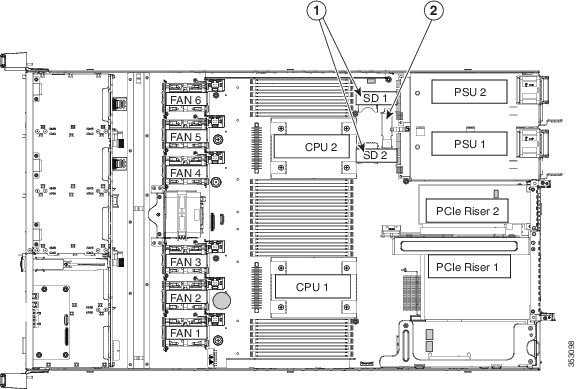
|
|
|
Enabling or Disabling the Internal USB Port

The factory default is for all USB ports on the server to be enabled. However, the internal USB port can be enabled or disabled in the server BIOS. See Figure 3-19 for the location of the USB port on the motherboard.
Step 1![]() Enter the BIOS Setup Utility by pressing the F2 key when prompted during bootup.
Enter the BIOS Setup Utility by pressing the F2 key when prompted during bootup.
Step 2![]() Navigate to the Advanced tab.
Navigate to the Advanced tab.
Step 3![]() On the Advanced tab, select USB Configuration.
On the Advanced tab, select USB Configuration.
Step 4![]() On the USB Configuration page, select USB Ports Configuration.
On the USB Configuration page, select USB Ports Configuration.
Step 5![]() Scroll to USB Port: Internal, press Enter, and then choose either Enabled or Disabled from the dialog box.
Scroll to USB Port: Internal, press Enter, and then choose either Enabled or Disabled from the dialog box.
Step 6![]() Press F10 to save and exit the utility.
Press F10 to save and exit the utility.
Replacing a Cisco Modular RAID Controller Riser (Internal Riser 3)
The server has a dedicated internal riser 3 that is only used for the Cisco modular RAID controller card. This riser plugs into a dedicated motherboard socket and provides a horizontal socket for the Cisco modular RAID controller card.
Step 1![]() Prepare the server for component installation:
Prepare the server for component installation:
a.![]() Power off the server as described in Shutting Down and Powering Off the Server.
Power off the server as described in Shutting Down and Powering Off the Server.
b.![]() Slide the server out the front of the rack far enough so that you can remove the top cover. You might have to detach cables from the rear panel to provide clearance.
Slide the server out the front of the rack far enough so that you can remove the top cover. You might have to detach cables from the rear panel to provide clearance.

c.![]() Remove the top cover as described in Removing and Replacing the Server Top Cover.
Remove the top cover as described in Removing and Replacing the Server Top Cover.
Step 2![]() Remove the existing RAID controller riser (see Figure 3-20):
Remove the existing RAID controller riser (see Figure 3-20):
a.![]() If the existing riser has a card in it, disconnect the SAS cable from the card.
If the existing riser has a card in it, disconnect the SAS cable from the card.
b.![]() Lift the riser straight up to disengage the riser from the motherboard socket. The riser bracket must also lift off of two pegs that hold it to the inner chassis wall.
Lift the riser straight up to disengage the riser from the motherboard socket. The riser bracket must also lift off of two pegs that hold it to the inner chassis wall.
d.![]() Remove the card from the riser. Loosen the single thumbscrew that secures the card to the riser bracket and then pull the card straight out from its socket on the riser (see Figure 3-21).
Remove the card from the riser. Loosen the single thumbscrew that secures the card to the riser bracket and then pull the card straight out from its socket on the riser (see Figure 3-21).
Step 3![]() Install a new RAID controller riser:
Install a new RAID controller riser:
a.![]() Install your RAID controller card into the new riser. See Replacing a Cisco Modular RAID Controller Card.
Install your RAID controller card into the new riser. See Replacing a Cisco Modular RAID Controller Card.
b.![]() Align the connector on the riser with the socket on the motherboard. At the same time, align the two slots on the back side of the bracket with the two pegs on the inner chassis wall.
Align the connector on the riser with the socket on the motherboard. At the same time, align the two slots on the back side of the bracket with the two pegs on the inner chassis wall.
c.![]() Push down gently to engage the riser connector with the motherboard socket. The metal riser bracket must also engage the two pegs that secure it to the chassis wall.
Push down gently to engage the riser connector with the motherboard socket. The metal riser bracket must also engage the two pegs that secure it to the chassis wall.
d.![]() Reconnect the SAS cable to its connector on the RAID controller card.
Reconnect the SAS cable to its connector on the RAID controller card.
Step 5![]() Replace the server in the rack, replace cables, and then power on the server by pressing the Power button.
Replace the server in the rack, replace cables, and then power on the server by pressing the Power button.
Figure 3-20 Cisco Modular RAID Controller Riser (Internal Riser 3) Location
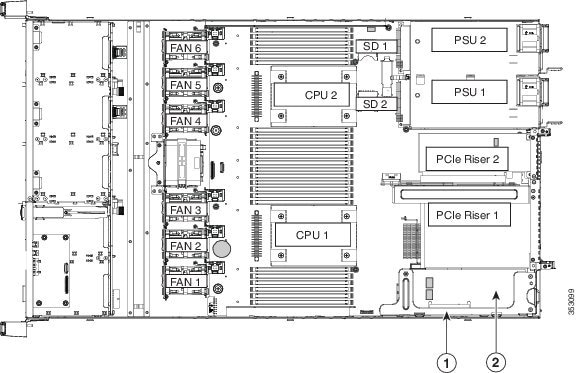
|
|
Cisco modular RAID controller riser assembly (top of bracket) |
|
Replacing a Cisco Modular RAID Controller Card
The server can use a Cisco modular RAID controller card that plugs into a horizontal socket on a dedicated internal riser 3.
- Replacing a Modular RAID Controller Transportable Memory Module (TMM)
- Replacing the Supercap Power Module (RAID Backup)

Note![]() You cannot use a hardware RAID controller card and the embedded RAID controller at the same time. See RAID Controller Considerations for details about RAID support.
You cannot use a hardware RAID controller card and the embedded RAID controller at the same time. See RAID Controller Considerations for details about RAID support.
RAID Card Firmware Compatibility
Firmware on the RAID controller must be verified for compatibility with the current Cisco IMC and BIOS versions that are installed on the server. If not compatible, upgrade or downgrade the RAID controller firmware accordingly using the Host Upgrade Utility (HUU) for your firmware release to bring it to a compatible level.
See the HUU guide for your Cisco IMC release for instructions on downloading and using the utility to bring server components to compatible levels: HUU Guides
Replacement Procedure
Step 1![]() Prepare the server for component installation:
Prepare the server for component installation:
a.![]() Power off the server as described in Shutting Down and Powering Off the Server.
Power off the server as described in Shutting Down and Powering Off the Server.
b.![]() Slide the server out the front of the rack far enough so that you can remove the top cover. You might have to detach cables from the rear panel to provide clearance.
Slide the server out the front of the rack far enough so that you can remove the top cover. You might have to detach cables from the rear panel to provide clearance.

c.![]() Remove the top cover as described in Removing and Replacing the Server Top Cover.
Remove the top cover as described in Removing and Replacing the Server Top Cover.
Step 2![]() Remove the RAID controller riser from the server (see Figure 3-20):
Remove the RAID controller riser from the server (see Figure 3-20):
a.![]() Disconnect the SAS cable from the existing RAID controller card.
Disconnect the SAS cable from the existing RAID controller card.
b.![]() Lift the riser straight up to disengage the riser from the motherboard socket. The riser bracket must also lift off of two pegs that hold it to the inner chassis wall.
Lift the riser straight up to disengage the riser from the motherboard socket. The riser bracket must also lift off of two pegs that hold it to the inner chassis wall.
Step 3![]() Remove the card from the riser:
Remove the card from the riser:
a.![]() Loosen the single thumbscrew that secures the card to the metal riser bracket (see Figure 3-21).
Loosen the single thumbscrew that secures the card to the metal riser bracket (see Figure 3-21).
b.![]() Pull the card straight out from its socket on the riser and the guide channel on the riser bracket.
Pull the card straight out from its socket on the riser and the guide channel on the riser bracket.
Step 4![]() Install the RAID controller card into the riser:
Install the RAID controller card into the riser:

a.![]() With the riser upside down, set the card on the riser. Align the right end of the card with the alignment channel on the riser; align the connector on the card edge with the socket on the riser (see Figure 3-21).
With the riser upside down, set the card on the riser. Align the right end of the card with the alignment channel on the riser; align the connector on the card edge with the socket on the riser (see Figure 3-21).
b.![]() Being careful to avoid scraping the underside of the card on the threaded standoff on the riser, push on both corners of the card to seat its connector in the riser socket.
Being careful to avoid scraping the underside of the card on the threaded standoff on the riser, push on both corners of the card to seat its connector in the riser socket.
c.![]() Tighten the single thumbscrew that secures the card to the riser bracket.
Tighten the single thumbscrew that secures the card to the riser bracket.
Step 5![]() Return the riser to the server:
Return the riser to the server:
a.![]() Align the connector on the riser with the socket on the motherboard. At the same time, align the two slots on the back side of the bracket with the two pegs on the inner chassis wall.
Align the connector on the riser with the socket on the motherboard. At the same time, align the two slots on the back side of the bracket with the two pegs on the inner chassis wall.
b.![]() Push down gently to engage the riser connector with the motherboard socket. The metal riser bracket must also engage the two pegs that secure it to the chassis wall.
Push down gently to engage the riser connector with the motherboard socket. The metal riser bracket must also engage the two pegs that secure it to the chassis wall.
Step 6![]() Reconnect the SAS cable to its connector on the RAID controller card.
Reconnect the SAS cable to its connector on the RAID controller card.
Step 8![]() Replace the server in the rack, replace cables, and then power on the server by pressing the Power button.
Replace the server in the rack, replace cables, and then power on the server by pressing the Power button.
Figure 3-21 Cisco Modular RAID Controller Card in Riser
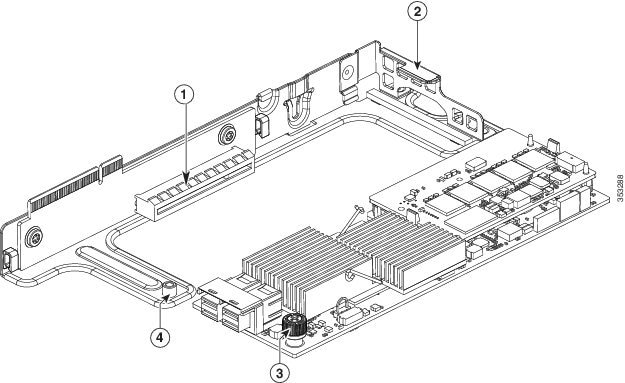
|
|
|
||
|
|
|
CAUTION: Do not scrape the underside of the card on this threaded standoff. |
Replacing a Modular RAID Controller Transportable Memory Module (TMM)
The transportable memory module (TMM) that attaches to the modular RAID controller card can be installed or replaced after-factory.
Step 1![]() Prepare the server for component installation:
Prepare the server for component installation:
a.![]() Power off the server as described in Shutting Down and Powering Off the Server.
Power off the server as described in Shutting Down and Powering Off the Server.
b.![]() Slide the server out the front of the rack far enough so that you can remove the top cover. You might have to detach cables from the rear panel to provide clearance.
Slide the server out the front of the rack far enough so that you can remove the top cover. You might have to detach cables from the rear panel to provide clearance.

c.![]() Remove the top cover as described in Removing and Replacing the Server Top Cover.
Remove the top cover as described in Removing and Replacing the Server Top Cover.
Step 2![]() Remove the RAID controller riser from the server (see Figure 3-20):
Remove the RAID controller riser from the server (see Figure 3-20):
a.![]() Disconnect the SAS cable from the existing RAID controller card.
Disconnect the SAS cable from the existing RAID controller card.
b.![]() Lift the riser straight up to disengage the riser from the motherboard socket. The riser bracket must also lift off of two pegs that hold it to the inner chassis wall.
Lift the riser straight up to disengage the riser from the motherboard socket. The riser bracket must also lift off of two pegs that hold it to the inner chassis wall.
Step 3![]() Remove the card from the riser:
Remove the card from the riser:
a.![]() Loosen the single thumbscrew that secures the card to the metal riser bracket (see Figure 3-21).
Loosen the single thumbscrew that secures the card to the metal riser bracket (see Figure 3-21).
b.![]() Pull the card straight out from its socket on the riser and the guide channel on the riser bracket.
Pull the card straight out from its socket on the riser and the guide channel on the riser bracket.
c.![]() Set the card on an antistatic surface.
Set the card on an antistatic surface.
Step 4![]() Remove a TMM from the modular RAID controller card (see Figure 3-22):
Remove a TMM from the modular RAID controller card (see Figure 3-22):
a.![]() The plastic bracket on the card has a securing plastic clip at each end of the TMM. Gently spread each clip away from the TMM.
The plastic bracket on the card has a securing plastic clip at each end of the TMM. Gently spread each clip away from the TMM.
b.![]() Pull straight up on the TMM to lift it off the two plastic guide pegs and the socket on the card.
Pull straight up on the TMM to lift it off the two plastic guide pegs and the socket on the card.
Step 5![]() Install a TMM to the modular RAID controller card (see Figure 3-22):
Install a TMM to the modular RAID controller card (see Figure 3-22):
a.![]() Align the TMM over the bracket on the card. Align the connector on the underside of the TMM with the socket on the card. Align the two guide holes on the TMM over the two guide pegs on the card.
Align the TMM over the bracket on the card. Align the connector on the underside of the TMM with the socket on the card. Align the two guide holes on the TMM over the two guide pegs on the card.

b.![]() Gently lower the TMM so that the guide holes on the TMM go over the guide pegs on the card.
Gently lower the TMM so that the guide holes on the TMM go over the guide pegs on the card.
c.![]() Press down on the TMM until the plastic clips on the bracket close over each end of the TMM.
Press down on the TMM until the plastic clips on the bracket close over each end of the TMM.
d.![]() Press down on the TMM to fully seat its connector with the socket on the card.
Press down on the TMM to fully seat its connector with the socket on the card.
Step 6![]() Install the modular RAID controller card back into the riser:
Install the modular RAID controller card back into the riser:

Note![]() If this is a first-time installation of your TMM, you must also install a SuperCap power module (SCPM). The SCPM cable attaches to a connector on the TMM. See Replacing the Supercap Power Module (RAID Backup).
If this is a first-time installation of your TMM, you must also install a SuperCap power module (SCPM). The SCPM cable attaches to a connector on the TMM. See Replacing the Supercap Power Module (RAID Backup).
a.![]() Connect the cable from the SuperCap power module (RAID battery) to the connector on the TMM (see Figure 3-22).
Connect the cable from the SuperCap power module (RAID battery) to the connector on the TMM (see Figure 3-22).
b.![]() With the riser upside down, align the connector on the card with the socket on the riser. The end of the card should also go into the guide channel on the riser bracket (see Figure 3-21).
With the riser upside down, align the connector on the card with the socket on the riser. The end of the card should also go into the guide channel on the riser bracket (see Figure 3-21).
c.![]() Carefully push on both corners of the card until it is seated in the socket.
Carefully push on both corners of the card until it is seated in the socket.
d.![]() Tighten the single thumbscrew that secures the card to the riser bracket.
Tighten the single thumbscrew that secures the card to the riser bracket.
Step 7![]() Return the riser to the server:
Return the riser to the server:
a.![]() Align the connector on the riser with the socket on the motherboard. At the same time, align the two slots on the back side of the bracket with the two pegs on the inner chassis wall.
Align the connector on the riser with the socket on the motherboard. At the same time, align the two slots on the back side of the bracket with the two pegs on the inner chassis wall.
b.![]() Push down gently to engage the riser connector with the motherboard socket. The metal riser bracket must also engage the two pegs that secure it to the chassis wall.
Push down gently to engage the riser connector with the motherboard socket. The metal riser bracket must also engage the two pegs that secure it to the chassis wall.
Step 8![]() Reconnect the SAS cable to its connector on the RAID controller card.
Reconnect the SAS cable to its connector on the RAID controller card.
Step 10![]() Replace the server in the rack, replace cables, and then power on the server by pressing the Power button.
Replace the server in the rack, replace cables, and then power on the server by pressing the Power button.
Figure 3-22 TMM on Modular RAID Controller Card
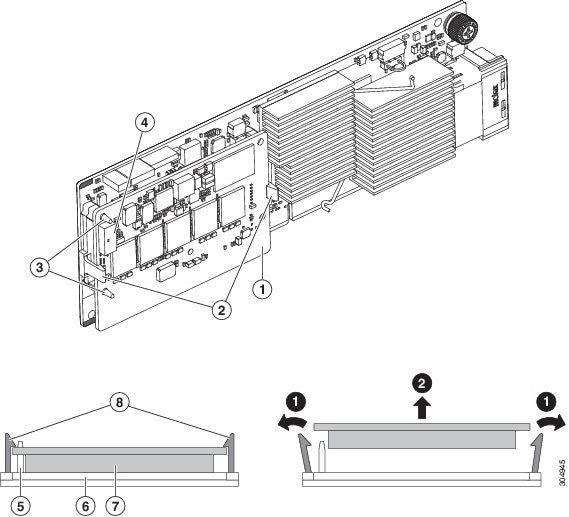
|
|
|
||
|
|
|
||
|
|
|
||
|
|
|
Replacing the Supercap Power Module (RAID Backup)
This server supports installation of one SuperCap Power module (SCPM). The unit mounts to a bracket that is in the middle of the row of fan modules (see Figure 3-23).
The SCPM provides approximately three years of backup for the disk write-back cache DRAM in the case of a sudden power loss by offloading the cache to the NAND flash.
- Replacing a Cisco Modular RAID Controller Card
- Replacing a Modular RAID Controller Transportable Memory Module (TMM)
Step 1![]() Remove an existing SCPM (see Figure 3-23).
Remove an existing SCPM (see Figure 3-23).
a.![]() Power off the server as described in Shutting Down and Powering Off the Server.
Power off the server as described in Shutting Down and Powering Off the Server.
b.![]() Slide the server out the front of the rack far enough so that you can remove the top cover. You might have to detach cables from the rear panel to provide clearance.
Slide the server out the front of the rack far enough so that you can remove the top cover. You might have to detach cables from the rear panel to provide clearance.

c.![]() Remove the top cover as described in Removing and Replacing the Server Top Cover.
Remove the top cover as described in Removing and Replacing the Server Top Cover.
d.![]() Disconnect the SCPM cable from the existing SCPM.
Disconnect the SCPM cable from the existing SCPM.
e.![]() Release the securing clip on the bracket retainer bar and then open the retainer bar (see Figure 3-23).
Release the securing clip on the bracket retainer bar and then open the retainer bar (see Figure 3-23).
f.![]() Lift the SCPM free of the bracket and set it aside.
Lift the SCPM free of the bracket and set it aside.
a.![]() Set the new SCPM into the mounting bracket.
Set the new SCPM into the mounting bracket.
b.![]() Connect the cable from the Cisco modular RAID controller to the new SCPM.
Connect the cable from the Cisco modular RAID controller to the new SCPM.
c.![]() Close the retainer bar over the SCPM. Push down until the securing clip clicks and holds down the retainer bar.
Close the retainer bar over the SCPM. Push down until the securing clip clicks and holds down the retainer bar.
e.![]() Replace the server in the rack, replace cables, and then power on the server by pressing the Power button.
Replace the server in the rack, replace cables, and then power on the server by pressing the Power button.
Figure 3-23 SCPM Bracket Location
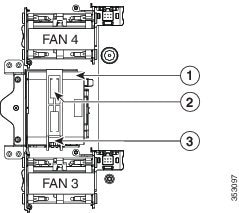
|
|
|
||
|
|
|
Replacing a Software RAID 5 Key Module
The server has a two-pin header on the motherboard for a RAID 5 key module. This module upgrades the embedded software RAID controller options to add RAID 5 support (see Embedded SATA RAID Controllers).
Step 1![]() Prepare the server for component installation:
Prepare the server for component installation:
a.![]() Power off the server as described in Shutting Down and Powering Off the Server.
Power off the server as described in Shutting Down and Powering Off the Server.
b.![]() Slide the server out the front of the rack far enough so that you can remove the top cover. You might have to detach cables from the rear panel to provide clearance.
Slide the server out the front of the rack far enough so that you can remove the top cover. You might have to detach cables from the rear panel to provide clearance.

c.![]() Remove the top cover as described in Removing and Replacing the Server Top Cover.
Remove the top cover as described in Removing and Replacing the Server Top Cover.
Step 2![]() Remove any existing software RAID 5 key module:
Remove any existing software RAID 5 key module:
a.![]() Locate the module on the motherboard (see Figure 3-24).
Locate the module on the motherboard (see Figure 3-24).
b.![]() Hold the retention clips on the header open while you grasp the RAID key board and pull straight up (see Figure 3-25).
Hold the retention clips on the header open while you grasp the RAID key board and pull straight up (see Figure 3-25).
Figure 3-24 RAID 5 Key Header Location on Motherboard
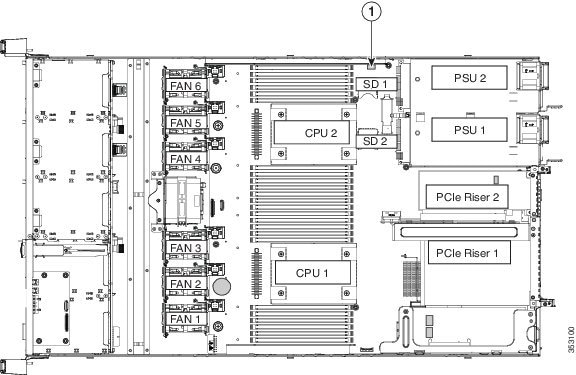
|
|
|
Step 3![]() Install a new software RAID 5 key module:
Install a new software RAID 5 key module:
a.![]() Align the module with the pins in the motherboard header.
Align the module with the pins in the motherboard header.
b.![]() Gently press down on the module until it is seated and the retention clip locks over the module (see Figure 3-25).
Gently press down on the module until it is seated and the retention clip locks over the module (see Figure 3-25).
Figure 3-25 Software RAID 5 Key Module Retention Clip
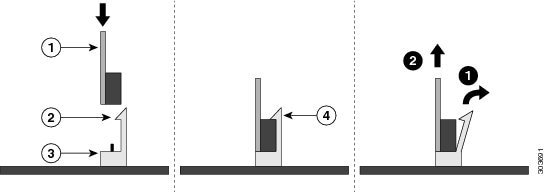
|
|
|
||
|
|
|
Step 5![]() Replace the server in the rack, replace cables, and then power on the server by pressing the Power button.
Replace the server in the rack, replace cables, and then power on the server by pressing the Power button.
Replacing a PCIe Riser Assembly
The server contains two PCIe risers that are attached to a single riser assembly. Riser 1 provides PCIe slot 1 and riser 2 provides PCIe slot 2, as shown in Figure 3-26. See Table 3-7 for a description of the PCIe slots on each riser.
Figure 3-26 Rear Panel, Showing PCIe Slots

To install or replace a PCIe riser, follow these steps:
Step 1![]() Remove the PCIe riser assembly that you are replacing:
Remove the PCIe riser assembly that you are replacing:
a.![]() Power off the server as described in Shutting Down and Powering Off the Server.
Power off the server as described in Shutting Down and Powering Off the Server.
b.![]() Slide the server out the front of the rack far enough so that you can remove the top cover. You might have to detach cables from the rear panel to provide clearance.
Slide the server out the front of the rack far enough so that you can remove the top cover. You might have to detach cables from the rear panel to provide clearance.

c.![]() Remove the top cover as described in Removing and Replacing the Server Top Cover.
Remove the top cover as described in Removing and Replacing the Server Top Cover.
d.![]() Use two hands to grasp the metal bracket of the riser assembly and lift straight up to disengage its connectors from the two sockets on the motherboard.
Use two hands to grasp the metal bracket of the riser assembly and lift straight up to disengage its connectors from the two sockets on the motherboard.
e.![]() If the riser has any cards installed, remove them from the riser.
If the riser has any cards installed, remove them from the riser.
Step 2![]() Install a new PCIe riser assembly:
Install a new PCIe riser assembly:
a.![]() If you removed any cards from the old riser assembly, install the cards to the new riser assembly (see Replacing a PCIe Card).
If you removed any cards from the old riser assembly, install the cards to the new riser assembly (see Replacing a PCIe Card).
b.![]() Position the riser assembly over its two sockets on the motherboard and over the chassis alignment channels (see Figure 3-27):
Position the riser assembly over its two sockets on the motherboard and over the chassis alignment channels (see Figure 3-27):
c.![]() Carefully push down on both ends of the riser assembly to fully engage its connectors with the two sockets on the motherboard.
Carefully push down on both ends of the riser assembly to fully engage its connectors with the two sockets on the motherboard.
Step 4![]() Replace the server in the rack, replace cables, and then power on the server by pressing the Power button.
Replace the server in the rack, replace cables, and then power on the server by pressing the Power button.
Figure 3-27 PCIe Riser Assembly Location and Alignment Channels
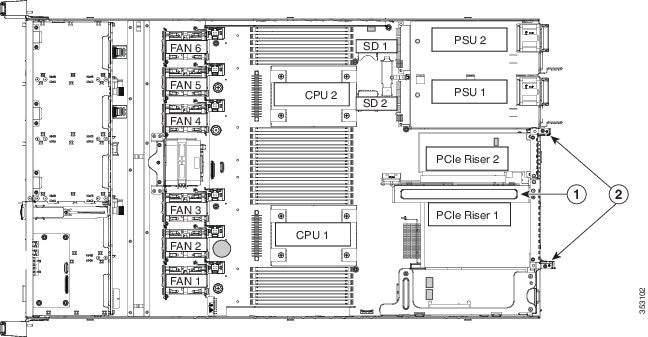
|
|
|
Replacing a PCIe Card

PCIe Slots
The server contains two toolless PCIe risers for horizontal installation of PCIe cards. See Figure 3-28 and Table 3-7 for a description of the PCIe slots on these risers.
Both slots support the network communications services interface (NCSI) protocol and standby power.
Figure 3-28 Rear Panel, Showing PCIe Slots

|
|
Lane Width |
|
|
|
|
|---|---|---|---|---|---|
2 (on riser version 2A)3 |
|||||
2 (on riser version 2B)4 |
Replacing a PCIe Card

Note![]() If you are installing a Cisco UCS Virtual Interface Card, there are prerequisite considerations. See Special Considerations for Cisco UCS Virtual Interface Cards.
If you are installing a Cisco UCS Virtual Interface Card, there are prerequisite considerations. See Special Considerations for Cisco UCS Virtual Interface Cards.

Note![]() If you are installing a RAID controller card, see RAID Controller Considerations for more information about supported cards and cabling.
If you are installing a RAID controller card, see RAID Controller Considerations for more information about supported cards and cabling.
To install or replace a PCIe card, follow these steps:
Step 1![]() Remove an existing PCIe card (or a blank filler panel) from the PCIe riser:
Remove an existing PCIe card (or a blank filler panel) from the PCIe riser:
a.![]() Shut down and power off the server as described in Shutting Down and Powering Off the Server.
Shut down and power off the server as described in Shutting Down and Powering Off the Server.
b.![]() Slide the server out the front of the rack far enough so that you can remove the top cover. You might have to detach cables from the rear panel to provide clearance.
Slide the server out the front of the rack far enough so that you can remove the top cover. You might have to detach cables from the rear panel to provide clearance.

c.![]() Remove the top cover as described in Removing and Replacing the Server Top Cover.
Remove the top cover as described in Removing and Replacing the Server Top Cover.
d.![]() Remove any cables from the ports of the PCIe card that you are replacing.
Remove any cables from the ports of the PCIe card that you are replacing.
e.![]() Use two hands to grasp the metal bracket of the riser assembly and lift straight up to disengage its connectors from the two sockets on the motherboard.
Use two hands to grasp the metal bracket of the riser assembly and lift straight up to disengage its connectors from the two sockets on the motherboard.
f.![]() Open the hinged plastic retainer that secures the rear-panel tab of the card (see Figure 3-29).
Open the hinged plastic retainer that secures the rear-panel tab of the card (see Figure 3-29).
g.![]() Pull evenly on both ends of the PCIe card to remove it from the socket on the PCIe riser.
Pull evenly on both ends of the PCIe card to remove it from the socket on the PCIe riser.
If the riser has no card, remove the blanking panel from the rear opening of the riser.
Step 2![]() Install a new PCIe card:
Install a new PCIe card:
a.![]() Open the hinged plastic retainer
Open the hinged plastic retainer
b.![]() With the hinged tab retainer open, align the new PCIe card with the empty socket on the PCIe riser.
With the hinged tab retainer open, align the new PCIe card with the empty socket on the PCIe riser.
c.![]() Push down evenly on both ends of the card until it is fully seated in the socket.
Push down evenly on both ends of the card until it is fully seated in the socket.
d.![]() Ensure that the card’s rear panel tab sits flat against the riser rear-panel opening and then close the hinged tab retainer over the card’s rear-panel tab (see Figure 3-29).
Ensure that the card’s rear panel tab sits flat against the riser rear-panel opening and then close the hinged tab retainer over the card’s rear-panel tab (see Figure 3-29).
e.![]() Position the PCIe riser over its two sockets on the motherboard and over the chassis alignment channels (see Figure 3-27).
Position the PCIe riser over its two sockets on the motherboard and over the chassis alignment channels (see Figure 3-27).
f.![]() Carefully push down on both ends of the PCIe riser to fully engage its connector with the sockets on the motherboard.
Carefully push down on both ends of the PCIe riser to fully engage its connector with the sockets on the motherboard.
h.![]() Replace the server in the rack, replace cables, and then power on the server by pressing the Power button.
Replace the server in the rack, replace cables, and then power on the server by pressing the Power button.
i.![]() If the card that you replaced was a RAID controller, continue with Restoring RAID Configuration After Replacing a RAID Controller.
If the card that you replaced was a RAID controller, continue with Restoring RAID Configuration After Replacing a RAID Controller.
Figure 3-29 PCIe Riser Assembly

|
|
|
Special Considerations for Cisco UCS Virtual Interface Cards
Table 3-8 describes the requirements for the supported Cisco UCS virtual interface cards (VICs).
The server can support up to two PCIe-style VICs plus one mLOM-style VIC.

Note![]() If you use the Cisco Card NIC mode, you must also make a VIC Slot setting that matches where your VIC is installed. The options are Riser1, Riser2, and Flex-LOM. See NIC Modes and NIC Redundancy Settings.
If you use the Cisco Card NIC mode, you must also make a VIC Slot setting that matches where your VIC is installed. The options are Riser1, Riser2, and Flex-LOM. See NIC Modes and NIC Redundancy Settings.
If you want to use the Cisco UCS VIC card for Cisco UCS Manager integration, also see the Cisco UCS C-Series Server Integration with UCS Manager Guides for details about supported configurations, cabling, and other requirements.
|
|
|
|
|
|
|
|
|---|---|---|---|---|---|---|
|
|
||||||
|
|
||||||
|
|
Supported with UCS manager 3.1(1) or later and 2.2(7b) or later |
|||||
|
|
||||||
|
|
||||||
|
|

Note![]() The Cisco UCS VIC 1227 (UCSC-MLOM-CSC-02) is not compatible to use in Cisco Card NIC mode with a certain Cisco SFP+ module. Do not use a Cisco SFP+ module part number 37-0961-01 that has a serial number in the range MOC1238xxxx to MOC1309xxxx. If you use the Cisco UCS VIC 1227 in Cisco Card NIC mode, use a different part number Cisco SFP+ module, or you can use this part number 37-0961-01 if the serial number is not included in the range above. See the data sheet for this adapter for other supported SFP+ modules: Cisco UCS VIC 1227 Data Sheet
The Cisco UCS VIC 1227 (UCSC-MLOM-CSC-02) is not compatible to use in Cisco Card NIC mode with a certain Cisco SFP+ module. Do not use a Cisco SFP+ module part number 37-0961-01 that has a serial number in the range MOC1238xxxx to MOC1309xxxx. If you use the Cisco UCS VIC 1227 in Cisco Card NIC mode, use a different part number Cisco SFP+ module, or you can use this part number 37-0961-01 if the serial number is not included in the range above. See the data sheet for this adapter for other supported SFP+ modules: Cisco UCS VIC 1227 Data Sheet
Special Considerations for Cisco UCS Fusion ioDrive3 Storage Accelerator Cards
Table 3-9 describes the requirements for the supported Cisco UCS Fusion ioDrive3 cards.
|
|
|
|
|
|
|
|---|---|---|---|---|---|
|
|
All6 |
||||
|
|
Half height7 |
||||
|
|
|||||
|
|
|
6.All slots can be enabled to provide more than the default 25 W power draw for higher performance on some cards. See Enabling Higher Power-Draw for Fusion ioDrive3 Cards. 7.A rear-panel tab adapter is required to fit the half-height cards in full-height slots. |
Enabling Higher Power-Draw for Fusion ioDrive3 Cards
Some Fusion ioDrive3 accelerator cards such as the 5800 GB card draw 25 W by default but can achieve higher performance when the PCIe slot is configured to provide more than 25 W for the device.
PCIe slots that can be configured to support more than 25 W power draw: All.
All slots can support the higher device power draw of 55 W (75 W maximum) when configured with the override parameter in the IO Accelerator VSL software.

Note![]() See the Cisco UCS power calculator to determine the total power draw for your exact server configuration: http://www.cisco.com/assets/cdc_content_elements/flash/dataCenter/cisco_ucs_power_calculator/
See the Cisco UCS power calculator to determine the total power draw for your exact server configuration: http://www.cisco.com/assets/cdc_content_elements/flash/dataCenter/cisco_ucs_power_calculator/
The override parameter in the IO Accelerator VSL software (in the /usr/modprove.d/iomemory-vsl.conf file) overrides the setting that prevents devices from drawing more than 25 W from the PCIe slot. The parameter is enabled by device, by using the device serial numbers.

Note![]() The override parameter is a setting for the IO Accelerator VSL software by server and is not stored in the device. When moved to a new server, the device defaults to the 25 W power limit until an external power cable is added or the override parameter is enabled for that device in the new server.
The override parameter is a setting for the IO Accelerator VSL software by server and is not stored in the device. When moved to a new server, the device defaults to the 25 W power limit until an external power cable is added or the override parameter is enabled for that device in the new server.
Step 1![]() Determine the serial number of the installed Fusion device by using the
Determine the serial number of the installed Fusion device by using the fio-status command in the IO Accelerator VSL software. Sample output is shown here:
In this example, 1149D0969 is the adapter serial number. If you have multiple Fusion ioDrive3 devices installed in your system, use the fio-beacon command to verify where each device is physically located.

Note![]() There is also a serial number label on the card, but we recommend that you use the
There is also a serial number label on the card, but we recommend that you use the fio-status command to confirm the serial number is an adapter serial number (FIO SN in the sample output above).
Step 2![]() Set the override parameter by editing the
Set the override parameter by editing the /usr/modprove.d/iomemory-vsl.conf file, which is installed when you install the device drivers.
Change the value for the external_power_override parameter, where the <value> for this parameter is a comma-separated list of adapter serial numbers.
Step 3![]() Reboot the server or unload and then load the drivers to enforce the parameter changes.
Reboot the server or unload and then load the drivers to enforce the parameter changes.
Installing Multiple PCIe Cards and Resolving Limited Resources
When a large number of PCIe add-on cards are installed in the server, the system might run out of the following resources required for PCIe devices:
The topics in this section provide guidelines for resolving the issues related to these limited resources:
Resolving Insufficient Memory Space to Execute Option ROMs
The system has very limited memory to execute PCIe legacy option ROMs, so when a large number of PCIe add-on cards are installed in the server, the system BIOS might not able to execute all of the option ROMs. The system BIOS loads and executes the option ROMs in the order that the PCIe cards are enumerated (slot 1, slot 2, slot 3, and so on).
If the system BIOS does not have sufficient memory space to load any PCIe option ROM, it skips loading that option ROM, reports a system event log (SEL) event to the Cisco IMC controller and reports the following error in the Error Manager page of the BIOS Setup utility:
To resolve this issue, disable the Option ROMs that are not needed for system booting. The BIOS Setup Utility provides the setup options to enable or disable the Option ROMs at the PCIe slot level for the PCIe expansion slots and at the port level for the onboard NICs. These options can be found in the BIOS Setup Utility Advanced > PCI Configuration page.
If the server is configured to boot primarily from RAID storage, make sure that the option ROMs for the slots where your RAID controllers installed are enabled in the BIOS, depending on your RAID controller configuration.
If the RAID controller does not appear in the system boot order even with the option ROMs for those slots enabled, the RAID controller option ROM might not have sufficient memory space to execute. In that case, disable other option ROMs that are not needed for the system configuration to free up some memory space for the RAID controller option ROM.
If the system is configured to primarily perform PXE boot from onboard NICs, make sure that the option ROMs for the onboard NICs to be booted from are enabled in the BIOS Setup Utility. Disable other option ROMs that are not needed to create sufficient memory space for the onboard NICs.
Resolving Insufficient 16-Bit I/O Space
The system has only 64 KB of legacy 16-bit I/O resources available. This 64 KB of I/O space is divided between the CPUs in the system because the PCIe controller is integrated into the CPUs. This server BIOS has the capability to dynamically detect the 16-bit I/O resource requirement for each CPU and then balance the 16-bit I/O resource allocation between the CPUs during the PCI bus enumeration phase of the BIOS POST.
When a large number of PCIe cards are installed in the system, the system BIOS might not have sufficient I/O space for some PCIe devices. If the system BIOS is not able to allocate the required I/O resources for any PCIe devices, the following symptoms have been observed:
- The system might get stuck in an infinite reset loop.
- The BIOS might appear to hang while initializing PCIe devices.
- The PCIe option ROMs might take excessive time to complete, which appears to lock up the system.
- PCIe boot devices might not be accessible from the BIOS.
- PCIe option ROMs might report initialization errors. These errors are seen before the BIOS passes control to the operating system.
- The keyboard might not work.
To work around this problem, rebalance the 16-bit I/O load using the following methods:
1.![]() Physically remove any unused PCIe cards.
Physically remove any unused PCIe cards.
2.![]() If the system has one or more Cisco virtual interface cards (VICs) installed, disable the PXE boot on the VICs that are not required for the system boot configuration by using the Network Adapters page in the Cisco IMC Web UI to free up some 16-bit I/O resources. Each VIC uses a minimum 16 KB of 16-bit I/O resource, so disabling PXE boot on Cisco VICs would free up some 16-bit I/O resources that can be used for other PCIe cards that are installed in the system.
If the system has one or more Cisco virtual interface cards (VICs) installed, disable the PXE boot on the VICs that are not required for the system boot configuration by using the Network Adapters page in the Cisco IMC Web UI to free up some 16-bit I/O resources. Each VIC uses a minimum 16 KB of 16-bit I/O resource, so disabling PXE boot on Cisco VICs would free up some 16-bit I/O resources that can be used for other PCIe cards that are installed in the system.
Installing and Enabling a Trusted Platform Module (TPM)
The trusted platform module (TPM) is a small circuit board that attaches to a motherboard socket. The socket location is on the motherboard between the power supplies and PCIe riser 2 (see Figure 3-30).
TPM 2.0 Considerations
Trusted platform module (TPM) version 2.0 is supported on Intel v3- or Intel v4-based platforms.
If there is an existing TPM 1.2 installed in the server, you cannot upgrade to TPM 2.0.
If there is no existing TPM in the server, you can install TPM 2.0. You must first upgrade to Intel v4 code, regardless of whether the installed CPU is Intel v3 or v4. TPM 2.0 requires Intel v4 code or later.


Note![]() If the TPM 2.0 becomes unresponsive, reboot the server.
If the TPM 2.0 becomes unresponsive, reboot the server.
|
|
|
|
|
|---|---|---|---|
Installing the TPM Hardware
This section contains the following procedures, which must be followed in this order when installing and enabling a TPM:
1.![]() Installing the TPM Hardware
Installing the TPM Hardware
2.![]() Enabling TPM Support in the BIOS
Enabling TPM Support in the BIOS
3.![]() Enabling the Intel TXT Feature in the BIOS
Enabling the Intel TXT Feature in the BIOS

Note![]() For security purposes, the TPM is installed with a one-way screw. It cannot be removed with a standard screwdriver.
For security purposes, the TPM is installed with a one-way screw. It cannot be removed with a standard screwdriver.
Step 1![]() Prepare the server for component installation.
Prepare the server for component installation.
a.![]() Power off the server as described in Shutting Down and Powering Off the Server.
Power off the server as described in Shutting Down and Powering Off the Server.
b.![]() Slide the server out the front of the rack far enough so that you can remove the top cover. You might have to detach cables from the rear panel to provide clearance.
Slide the server out the front of the rack far enough so that you can remove the top cover. You might have to detach cables from the rear panel to provide clearance.

c.![]() Remove the top cover as described in Removing and Replacing the Server Top Cover.
Remove the top cover as described in Removing and Replacing the Server Top Cover.
d.![]() Check if there is a card installed in PCIe riser 2. See Figure 3-30.
Check if there is a card installed in PCIe riser 2. See Figure 3-30.
- If no card is installed in PCIe riser 2, you can access the TPM socket. Go to Step 2.
- If a card is installed in PCIe riser 2, remove the PCIe riser assembly from the chassis. See Replacing a PCIe Riser Assembly for details.
Step 2![]() Install a TPM (see Figure 3-30):
Install a TPM (see Figure 3-30):
a.![]() Locate the TPM socket on the motherboard, as shown in Figure 3-30.
Locate the TPM socket on the motherboard, as shown in Figure 3-30.
b.![]() Align the connector that is on the bottom of the TPM circuit board with the motherboard TPM socket. Align the screw hole on the TPM board with the screw hole adjacent to the TPM socket.
Align the connector that is on the bottom of the TPM circuit board with the motherboard TPM socket. Align the screw hole on the TPM board with the screw hole adjacent to the TPM socket.
c.![]() Push down evenly on the TPM to seat it in the motherboard socket.
Push down evenly on the TPM to seat it in the motherboard socket.
d.![]() Install the single one-way screw that secures the TPM to the motherboard.
Install the single one-way screw that secures the TPM to the motherboard.
e.![]() If you removed the PCIe riser assembly, return it to the server now. See Replacing a PCIe Riser Assembly for details.
If you removed the PCIe riser assembly, return it to the server now. See Replacing a PCIe Riser Assembly for details.
g.![]() Replace the server in the rack and then power on the server by pressing the Power button.
Replace the server in the rack and then power on the server by pressing the Power button.
Step 3![]() Continue with Enabling TPM Support in the BIOS.
Continue with Enabling TPM Support in the BIOS.
Figure 3-30 TPM Socket Location on Motherboard
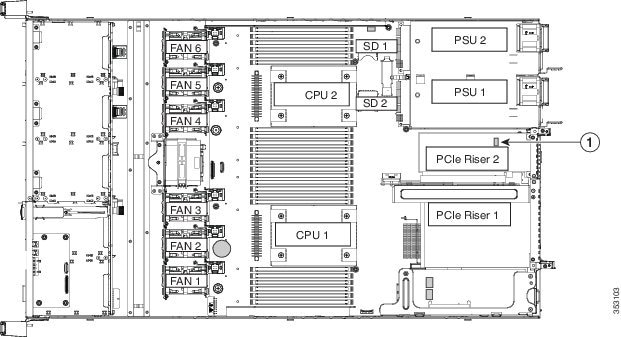
|
|
|
Enabling TPM Support in the BIOS

Note![]() After hardware installation, you must enable TPM support in the BIOS.
After hardware installation, you must enable TPM support in the BIOS.

Note![]() You must set a BIOS Administrator password before performing this procedure. To set this password, press the F2 key when prompted during system boot to enter the BIOS Setup utility. Then navigate to Security > Set Administrator Password and enter the new password twice as prompted.
You must set a BIOS Administrator password before performing this procedure. To set this password, press the F2 key when prompted during system boot to enter the BIOS Setup utility. Then navigate to Security > Set Administrator Password and enter the new password twice as prompted.
a.![]() Watch during bootup for the F2 prompt, and then press F2 to enter BIOS setup.
Watch during bootup for the F2 prompt, and then press F2 to enter BIOS setup.
b.![]() Log in to the BIOS Setup Utility with your BIOS Administrator password.
Log in to the BIOS Setup Utility with your BIOS Administrator password.
c.![]() On the BIOS Setup Utility window, choose the Advanced tab.
On the BIOS Setup Utility window, choose the Advanced tab.
d.![]() Choose Trusted Computing to open the TPM Security Device Configuration window.
Choose Trusted Computing to open the TPM Security Device Configuration window.
e.![]() Change TPM SUPPORT to Enabled.
Change TPM SUPPORT to Enabled.
f.![]() Press F10 to save your settings and reboot the server.
Press F10 to save your settings and reboot the server.
Step 2![]() Verify that TPM support is now enabled:
Verify that TPM support is now enabled:
a.![]() Watch during bootup for the F2 prompt, and then press F2 to enter BIOS setup.
Watch during bootup for the F2 prompt, and then press F2 to enter BIOS setup.
b.![]() Log into the BIOS Setup utility with your BIOS Administrator password.
Log into the BIOS Setup utility with your BIOS Administrator password.
d.![]() Choose Trusted Computing to open the TPM Security Device Configuration window.
Choose Trusted Computing to open the TPM Security Device Configuration window.
e.![]() Verify that TPM SUPPORT and TPM State are Enabled.
Verify that TPM SUPPORT and TPM State are Enabled.
Step 3![]() Continue with Enabling the Intel TXT Feature in the BIOS.
Continue with Enabling the Intel TXT Feature in the BIOS.
Enabling the Intel TXT Feature in the BIOS
Intel Trusted Execution Technology (TXT) provides greater protection for information that is used and stored on the business server. A key aspect of that protection is the provision of an isolated execution environment and associated sections of memory where operations can be conducted on sensitive data, invisibly to the rest of the system. Intel TXT provides for a sealed portion of storage where sensitive data such as encryption keys can be kept, helping to shield them from being compromised during an attack by malicious code.

Note![]() You must be logged in as the BIOS administrator to perform this procedure. If you have not done so already, set a BIOS administrator password on the Security tab of the BIOS Setup utility.
You must be logged in as the BIOS administrator to perform this procedure. If you have not done so already, set a BIOS administrator password on the Security tab of the BIOS Setup utility.
Step 1![]() Reboot the server and watch for the prompt to press F2.
Reboot the server and watch for the prompt to press F2.
Step 2![]() When prompted, press F2 to enter the BIOS Setup utility.
When prompted, press F2 to enter the BIOS Setup utility.
Step 3![]() Verify that the prerequisite BIOS values are enabled:
Verify that the prerequisite BIOS values are enabled:
b.![]() Choose Intel TXT(LT-SX) Configuration to open the Intel TXT(LT-SX) Hardware Support window.
Choose Intel TXT(LT-SX) Configuration to open the Intel TXT(LT-SX) Hardware Support window.
c.![]() Verify that the following items are listed as Enabled:
Verify that the following items are listed as Enabled:
–![]() VT-d Support (default is Enabled)
VT-d Support (default is Enabled)
–![]() VT Support (default is Enabled)
VT Support (default is Enabled)
- If VT-d Support and VT Support are already enabled, skip to Step 4.
- If VT-d Support and VT Support are not enabled, continue with the next steps to enable them.
d.![]() Press Escape to return to the BIOS Setup utility Advanced tab.
Press Escape to return to the BIOS Setup utility Advanced tab.
e.![]() On the Advanced tab, choose Processor Configuration to open the Processor Configuration window.
On the Advanced tab, choose Processor Configuration to open the Processor Configuration window.
f.![]() Set Intel (R) VT and Intel (R) VT-d to Enabled.
Set Intel (R) VT and Intel (R) VT-d to Enabled.
Step 4![]() Enable the Intel Trusted Execution Technology (TXT) feature:
Enable the Intel Trusted Execution Technology (TXT) feature:
a.![]() Return to the Intel TXT(LT-SX) Hardware Support window if you are not already there.
Return to the Intel TXT(LT-SX) Hardware Support window if you are not already there.
b.![]() Set TXT Support to Enabled.
Set TXT Support to Enabled.
Step 5![]() Press F10 to save your changes and exit the BIOS Setup utility.
Press F10 to save your changes and exit the BIOS Setup utility.
Replacing an mLOM Card
The server can use a modular LOM (mLOM) card to provide additional rear-panel connectivity. The mLOM card socket remains powered when the server is in 12 V standby power mode and it supports the network communications services interface (NCSI) protocol.
Step 1![]() Remove any existing mLOM card (or a blanking panel):
Remove any existing mLOM card (or a blanking panel):
a.![]() Power off the server as described in Shutting Down and Powering Off the Server.
Power off the server as described in Shutting Down and Powering Off the Server.
b.![]() Slide the server out the front of the rack far enough so that you can remove the top cover. You might have to detach cables from the rear panel to provide clearance.
Slide the server out the front of the rack far enough so that you can remove the top cover. You might have to detach cables from the rear panel to provide clearance.

c.![]() Remove the top cover as described in Removing and Replacing the Server Top Cover.
Remove the top cover as described in Removing and Replacing the Server Top Cover.
Step 2![]() See the location of the mLOM socket in Figure 3-31. You might have to remove PCIe riser 1 and the Cisco modular RAID controller riser to provide clearance.
See the location of the mLOM socket in Figure 3-31. You might have to remove PCIe riser 1 and the Cisco modular RAID controller riser to provide clearance.
- If there is no card in PCIe riser 1 or the RAID card riser, you can access the mLOM socket. Continue with Step 3.
- If there is a card in PCIe riser 1 or the RAID card riser, remove those risers to provide clearance. See Replacing a PCIe Riser Assembly and Replacing a Cisco Modular RAID Controller Card for instructions.
Step 3![]() Loosen the single thumbscrew that secures the mLOM card to the chassis floor and then slide the mLOM card horizontally to disengage its connector from the motherboard socket.
Loosen the single thumbscrew that secures the mLOM card to the chassis floor and then slide the mLOM card horizontally to disengage its connector from the motherboard socket.
Step 4![]() Install a new mLOM card:
Install a new mLOM card:
a.![]() Set the mLOM card on the chassis floor so that its connector is aligned with the motherboard socket and its thumbscrew is aligned with the standoff on the chassis floor.
Set the mLOM card on the chassis floor so that its connector is aligned with the motherboard socket and its thumbscrew is aligned with the standoff on the chassis floor.
b.![]() Push the card’s connector into the motherboard socket horizontally.
Push the card’s connector into the motherboard socket horizontally.
c.![]() Tighten the thumbscrew to secure the card to the chassis floor.
Tighten the thumbscrew to secure the card to the chassis floor.
Step 5![]() If you removed PCIe riser 1 or the RAID card riser, return them to the server. See Replacing a PCIe Riser Assembly or Replacing a Cisco Modular RAID Controller Card for instructions.
If you removed PCIe riser 1 or the RAID card riser, return them to the server. See Replacing a PCIe Riser Assembly or Replacing a Cisco Modular RAID Controller Card for instructions.
Step 7![]() Replace the server in the rack, replace cables, and then power on the server by pressing the Power button.
Replace the server in the rack, replace cables, and then power on the server by pressing the Power button.
Figure 3-31 mLOM Card Socket Location
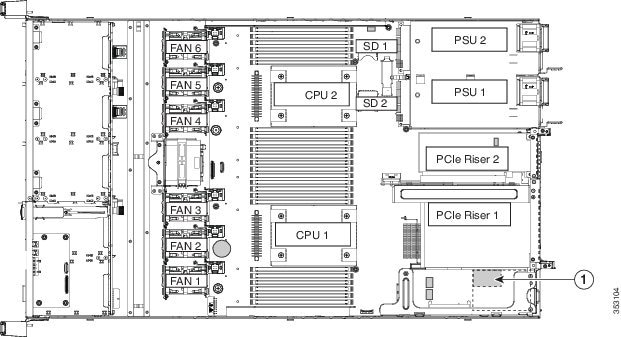
|
|
mLOM card socket location on motherboard (under a PCIe riser 1 card and the RAID controller card) |
|
Replacing Power Supplies
The server can have one or two power supplies. When two power supplies are installed they are redundant as 1+1.
- Replacing an AC Power Supply
- Installing a DC Power Supply (UCSC-PSUV2-1050DC)
- Installation Grounding
- See also Power Specifications for more information about the power supplies.
- See also Rear Panel LEDs and Buttons for information about the power supply LEDs.

Note![]() If you have ordered a server with power supply redundancy (two power supplies), you do not have to power off the server to replace power supplies because they are redundant as 1+1.
If you have ordered a server with power supply redundancy (two power supplies), you do not have to power off the server to replace power supplies because they are redundant as 1+1.

Note![]() Do not mix power supply types or wattages in the server.
Do not mix power supply types or wattages in the server.
Replacing an AC Power Supply
Step 1![]() Remove the power supply that you are replacing or a blank panel from an empty bay (see Figure 3-32):
Remove the power supply that you are replacing or a blank panel from an empty bay (see Figure 3-32):
a.![]() Perform one of the following actions:
Perform one of the following actions:
–![]() If your server has only one power supply, shut down and power off the server as described in the “Shutting Down and Powering Off the Server” section.
If your server has only one power supply, shut down and power off the server as described in the “Shutting Down and Powering Off the Server” section.
–![]() If your server has two power supplies, you do not have to shut down the server.
If your server has two power supplies, you do not have to shut down the server.
b.![]() Remove the power cord from the power supply that you are replacing.
Remove the power cord from the power supply that you are replacing.
c.![]() Grasp the power supply handle while pinching the release lever toward the handle.
Grasp the power supply handle while pinching the release lever toward the handle.
d.![]() Pull the power supply out of the bay.
Pull the power supply out of the bay.
Step 2![]() Install a new power supply:
Install a new power supply:
a.![]() Grasp the power supply handle and insert the new power supply into the empty bay.
Grasp the power supply handle and insert the new power supply into the empty bay.
b.![]() Push the power supply into the bay until the release lever locks.
Push the power supply into the bay until the release lever locks.
c.![]() Connect the power cord to the new power supply.
Connect the power cord to the new power supply.
d.![]() If you shut down the server, press the Power button to return the server to main power mode.
If you shut down the server, press the Power button to return the server to main power mode.
Figure 3-32 Removing and Replacing Power Supplies

|
|
|
||
|
|
|
Installing a DC Power Supply (UCSC-PSUV2-1050DC)

Warning![]() A readily accessible two-poled disconnect device must be incorporated in the fixed wiring. Statement 1022
A readily accessible two-poled disconnect device must be incorporated in the fixed wiring. Statement 1022

Warning![]() This product requires short-circuit (overcurrent) protection, to be provided as part of the building installation. Install only in accordance with national and local wiring regulations. Statement 1045
This product requires short-circuit (overcurrent) protection, to be provided as part of the building installation. Install only in accordance with national and local wiring regulations. Statement 1045

Warning![]() Installation of the equipment must comply with local and national electrical codes. Statement 1074
Installation of the equipment must comply with local and national electrical codes. Statement 1074

Step 1![]() Turn off the DC power source from your facility’s circuit breaker to avoid electric shock hazard.
Turn off the DC power source from your facility’s circuit breaker to avoid electric shock hazard.

Note![]() The required DC input cable is Cisco part CAB-48DC-40A-8AWG. This 3-meter cable has a 3-pin connector on one end that is keyed to the DC input socket on the power supply, as shown in Figure 3-33. The other end of the cable has no connector so that you can wire it to your facility’s DC power.
The required DC input cable is Cisco part CAB-48DC-40A-8AWG. This 3-meter cable has a 3-pin connector on one end that is keyed to the DC input socket on the power supply, as shown in Figure 3-33. The other end of the cable has no connector so that you can wire it to your facility’s DC power.
Step 2![]() Wire the non-terminated end of the cable to your facility’s DC power input source.
Wire the non-terminated end of the cable to your facility’s DC power input source.
Step 3![]() Connect the terminated end of the cable to the socket on the power supply. The connector is keyed so that the wires align for correct polarity and ground, as shown in Figure 3-33.
Connect the terminated end of the cable to the socket on the power supply. The connector is keyed so that the wires align for correct polarity and ground, as shown in Figure 3-33.
Step 4![]() Return DC power from your facility’s circuit breaker.
Return DC power from your facility’s circuit breaker.
Step 5![]() See Installation Grounding for information about additional chassis grounding.
See Installation Grounding for information about additional chassis grounding.
Figure 3-33 1050 W, –48 VDC Power Supply and Cable

|
|
|
See Rear Panel LEDs and Buttons for details. |
|
|
|
|
Installation Grounding
AC power supplies have internal grounding and so no additional grounding is required when the supported AC power cords are used.
When using a DC power supply, additional grounding of the server chassis to the earth ground of the rack is available. A screw hole for use with your grounding lug and grounding wire are supplied on the chassis rear panel.

Note![]() The grounding point on the chassis is sized for a single #10-32 screw. A lock-washer is required to secure the lug to the chassis. You must provide your own screw with lock-washer, grounding lug, and grounding wire. The grounding lug must be a single-hole lug that fits a #10-32 screw and 14 AWG wire. The grounding cable that you provide must be 14 AWG (2 mm), minimum 60° C wire, or as permitted by the local code.
The grounding point on the chassis is sized for a single #10-32 screw. A lock-washer is required to secure the lug to the chassis. You must provide your own screw with lock-washer, grounding lug, and grounding wire. The grounding lug must be a single-hole lug that fits a #10-32 screw and 14 AWG wire. The grounding cable that you provide must be 14 AWG (2 mm), minimum 60° C wire, or as permitted by the local code.
See Figure 3-32 for the location of the grounding lug screw-hole on the chassis rear panel.
Service DIP Switches
This section includes the following topics:
- DIP Switch Location on the Motherboard
- Using the BIOS Recovery DIP Switch
- Using the Clear Password DIP Switch
- Using the Clear CMOS DIP Switch
DIP Switch Location on the Motherboard
See Figure 3-34. The position of the block of DIP switches (SW6) is shown in red. In the magnified view, all switches are shown in the default position.
Figure 3-34 Service DIP Switches (SW6)
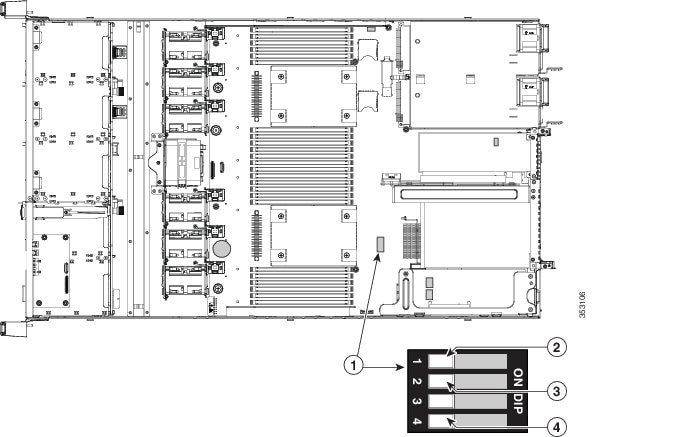
|
|
|
||
|
|
|
Using the BIOS Recovery DIP Switch

Note![]() The following procedures use a
The following procedures use a recovery.cap recovery file. In Cisco IMC releases 3.0(1) and later, this recovery file has been renamed bios.cap.
Depending on which stage the BIOS becomes corrupted, you might see different behavior.

Note![]() As indicated by the message shown above, there are two procedures for recovering the BIOS. Try procedure 1 first. If that procedure does not recover the BIOS, use procedure 2.
As indicated by the message shown above, there are two procedures for recovering the BIOS. Try procedure 1 first. If that procedure does not recover the BIOS, use procedure 2.
Procedure 1: Reboot with recovery.cap (or bios.cap) File
Step 1![]() Download the BIOS update package and extract it to a temporary location.
Download the BIOS update package and extract it to a temporary location.
Step 2![]() Copy the contents of the extracted recovery folder to the root directory of a USB thumb drive. The recovery folder contains the recovery.cap (or bios.cap) file that is required in this procedure.
Copy the contents of the extracted recovery folder to the root directory of a USB thumb drive. The recovery folder contains the recovery.cap (or bios.cap) file that is required in this procedure.

Note![]() The recovery.cap (or bios.cap) file must be in the root directory of the USB thumb drive. Do not rename this file. The USB thumb drive must be formatted with either FAT16 or FAT32 file systems.
The recovery.cap (or bios.cap) file must be in the root directory of the USB thumb drive. Do not rename this file. The USB thumb drive must be formatted with either FAT16 or FAT32 file systems.
Step 3![]() Insert the USB thumb drive into a USB port on the server.
Insert the USB thumb drive into a USB port on the server.
Step 5![]() Return the server to main power mode by pressing the Power button on the front panel.
Return the server to main power mode by pressing the Power button on the front panel.
The server boots with the updated BIOS boot block. When the BIOS detects a valid recovery.cap (or bios.cap) file on the USB thumb drive, it displays this message:
System would flash the BIOS image now...
System would restart with recovered image after a few seconds...
Step 6![]() Wait for server to complete the BIOS update, and then remove the USB thumb drive from the server.
Wait for server to complete the BIOS update, and then remove the USB thumb drive from the server.

Note![]() During the BIOS update, Cisco IMC shuts down the server and the screen goes blank for about 10 minutes. Do not unplug the power cords during this update. Cisco IMC powers on the server after the update is complete.
During the BIOS update, Cisco IMC shuts down the server and the screen goes blank for about 10 minutes. Do not unplug the power cords during this update. Cisco IMC powers on the server after the update is complete.
Procedure 2: Use BIOS Recovery DIP switch and recovery.cap (or bios.cap) File
See Figure 3-34 for the location of the SW8 block of DIP switches.
Step 1![]() Download the BIOS update package and extract it to a temporary location.
Download the BIOS update package and extract it to a temporary location.
Step 2![]() Copy the contents of the extracted recovery folder to the root directory of a USB thumb drive. The recovery folder contains the recovery.cap (or bios.cap) file that is required in this procedure.
Copy the contents of the extracted recovery folder to the root directory of a USB thumb drive. The recovery folder contains the recovery.cap (or bios.cap) file that is required in this procedure.

Note![]() The recovery.cap (or bios.cap) file must be in the root directory of the USB thumb drive. Do not rename this file. The USB thumb drive must be formatted with either FAT16 or FAT32 file systems.
The recovery.cap (or bios.cap) file must be in the root directory of the USB thumb drive. Do not rename this file. The USB thumb drive must be formatted with either FAT16 or FAT32 file systems.
Step 3![]() Power off the server as described in Shutting Down and Powering Off the Server.
Power off the server as described in Shutting Down and Powering Off the Server.
Step 4![]() Disconnect all power cords from the power supplies.
Disconnect all power cords from the power supplies.
Step 5![]() Slide the server out the front of the rack far enough so that you can remove the top cover. You might have to detach cables from the rear panel to provide clearance.
Slide the server out the front of the rack far enough so that you can remove the top cover. You might have to detach cables from the rear panel to provide clearance.

Step 6![]() Remove the top cover as described in Removing and Replacing the Server Top Cover.
Remove the top cover as described in Removing and Replacing the Server Top Cover.
Step 7![]() Slide the BIOS recovery DIP switch from position 1 to the closed position (see Figure 3-34).
Slide the BIOS recovery DIP switch from position 1 to the closed position (see Figure 3-34).
Step 8![]() Reconnect AC power cords to the server. The server powers up to standby power mode.
Reconnect AC power cords to the server. The server powers up to standby power mode.
Step 9![]() Insert the USB thumb drive that you prepared in Step 2 into a USB port on the server.
Insert the USB thumb drive that you prepared in Step 2 into a USB port on the server.
Step 10![]() Return the server to main power mode by pressing the Power button on the front panel.
Return the server to main power mode by pressing the Power button on the front panel.
The server boots with the updated BIOS boot block. When the BIOS detects a valid recovery.cap (or bios.cap) file on the USB thumb drive, it displays this message:
System would flash the BIOS image now...
System would restart with recovered image after a few seconds...
Step 11![]() Wait for server to complete the BIOS update, and then remove the USB thumb drive from the server.
Wait for server to complete the BIOS update, and then remove the USB thumb drive from the server.

Note![]() During the BIOS update, Cisco IMC shuts down the server and the screen goes blank for about 10 minutes. Do not unplug the power cords during this update. Cisco IMC powers on the server after the update is complete.
During the BIOS update, Cisco IMC shuts down the server and the screen goes blank for about 10 minutes. Do not unplug the power cords during this update. Cisco IMC powers on the server after the update is complete.
Step 12![]() After the server has fully booted, power off the server again and disconnect all power cords.
After the server has fully booted, power off the server again and disconnect all power cords.
Step 13![]() Slide the BIOS recovery DIP switch from the closed position back to the default position 1 (see Figure 3-34).
Slide the BIOS recovery DIP switch from the closed position back to the default position 1 (see Figure 3-34).

Note![]() If you do not move the jumper, after recovery completion you see the prompt, “Please remove the recovery jumper.”
If you do not move the jumper, after recovery completion you see the prompt, “Please remove the recovery jumper.”
Step 14![]() Replace the top cover, replace the server in the rack, replace power cords and any other cables, and then power on the server by pressing the Power button.
Replace the top cover, replace the server in the rack, replace power cords and any other cables, and then power on the server by pressing the Power button.
Using the Clear Password DIP Switch
See Figure 3-34 for the location of this DIP switch. You can use this switch to clear the administrator password.
Step 1![]() Power off the server as described in Shutting Down and Powering Off the Server.
Power off the server as described in Shutting Down and Powering Off the Server.
Step 2![]() Disconnect all power cords from the power supplies.
Disconnect all power cords from the power supplies.
Step 3![]() Slide the server out the front of the rack far enough so that you can remove the top cover. You might have to detach cables from the rear panel to provide clearance.
Slide the server out the front of the rack far enough so that you can remove the top cover. You might have to detach cables from the rear panel to provide clearance.

Step 4![]() Remove the top cover as described in Removing and Replacing the Server Top Cover.
Remove the top cover as described in Removing and Replacing the Server Top Cover.
Step 5![]() Slide the clear password DIP switch from position 2 to the closed position (see Figure 3-34).
Slide the clear password DIP switch from position 2 to the closed position (see Figure 3-34).
Step 6![]() Reinstall the top cover and reconnect AC power cords to the server. The server powers up to standby power mode, indicated when the Power LED on the front panel is amber.
Reinstall the top cover and reconnect AC power cords to the server. The server powers up to standby power mode, indicated when the Power LED on the front panel is amber.
Step 7![]() Return the server to main power mode by pressing the Power button on the front panel. The server is in main power mode when the Power LED is green.
Return the server to main power mode by pressing the Power button on the front panel. The server is in main power mode when the Power LED is green.

Note![]() You must allow the entire server, not just the service processor, to reboot to main power mode to complete the reset. The state of the jumper cannot be determined without the host CPU running.
You must allow the entire server, not just the service processor, to reboot to main power mode to complete the reset. The state of the jumper cannot be determined without the host CPU running.
Step 8![]() Press the Power button to shut down the server to standby power mode, and then remove AC power cords from the server to remove all power.
Press the Power button to shut down the server to standby power mode, and then remove AC power cords from the server to remove all power.
Step 9![]() Remove the top cover from the server.
Remove the top cover from the server.
Step 10![]() Slide the clear password DIP switch from the closed position back to default position 2 (see Figure 3-34).
Slide the clear password DIP switch from the closed position back to default position 2 (see Figure 3-34).

Note![]() If you do not move the jumper, the password is cleared every time that you power-cycle the server.
If you do not move the jumper, the password is cleared every time that you power-cycle the server.
Step 11![]() Replace the top cover, replace the server in the rack, replace power cords and any other cables, and then power on the server by pressing the Power button.
Replace the top cover, replace the server in the rack, replace power cords and any other cables, and then power on the server by pressing the Power button.
Using the Clear CMOS DIP Switch
See Figure 3-34 for the location of this DIP switch. You can use this switch to clear the server’s CMOS settings in the case of a system hang. For example, if the server hangs because of incorrect settings and does not boot, use this jumper to invalidate the settings and reboot with defaults.

Step 1![]() Power off the server as described in Shutting Down and Powering Off the Server.
Power off the server as described in Shutting Down and Powering Off the Server.
Step 2![]() Disconnect all power cords from the power supplies.
Disconnect all power cords from the power supplies.
Step 3![]() Slide the server out the front of the rack far enough so that you can remove the top cover. You might have to detach cables from the rear panel to provide clearance.
Slide the server out the front of the rack far enough so that you can remove the top cover. You might have to detach cables from the rear panel to provide clearance.

Step 4![]() Remove the top cover as described in Removing and Replacing the Server Top Cover.
Remove the top cover as described in Removing and Replacing the Server Top Cover.
Step 5![]() Slide the clear CMOS DIP switch from position 4 to the closed position (see Figure 3-34).
Slide the clear CMOS DIP switch from position 4 to the closed position (see Figure 3-34).
Step 6![]() Reinstall the top cover and reconnect AC power cords to the server. The server powers up to standby power mode, indicated when the Power LED on the front panel is amber.
Reinstall the top cover and reconnect AC power cords to the server. The server powers up to standby power mode, indicated when the Power LED on the front panel is amber.
Step 7![]() Return the server to main power mode by pressing the Power button on the front panel. The server is in main power mode when the Power LED is green.
Return the server to main power mode by pressing the Power button on the front panel. The server is in main power mode when the Power LED is green.

Note![]() You must allow the entire server, not just the service processor, to reboot to main power mode to complete the reset. The state of the jumper cannot be determined without the host CPU running.
You must allow the entire server, not just the service processor, to reboot to main power mode to complete the reset. The state of the jumper cannot be determined without the host CPU running.
Step 8![]() Press the Power button to shut down the server to standby power mode, and then remove AC power cords from the server to remove all power.
Press the Power button to shut down the server to standby power mode, and then remove AC power cords from the server to remove all power.
Step 9![]() Remove the top cover from the server.
Remove the top cover from the server.
Step 10![]() Slide the clear CMOS DIP switch from the closed position back to default position 4 (see Figure 3-34).
Slide the clear CMOS DIP switch from the closed position back to default position 4 (see Figure 3-34).

Note![]() If you do not move the jumper, the CMOS settings are reset to the default every time that you power-cycle the server.
If you do not move the jumper, the CMOS settings are reset to the default every time that you power-cycle the server.
Step 11![]() Replace the top cover, replace the server in the rack, replace power cords and any other cables, and then power on the server by pressing the Power button.
Replace the top cover, replace the server in the rack, replace power cords and any other cables, and then power on the server by pressing the Power button.
 Feedback
Feedback